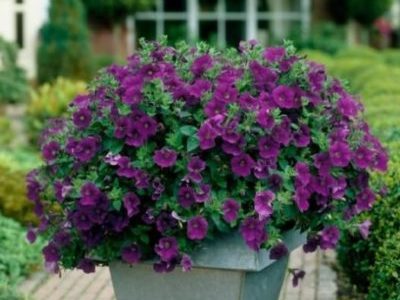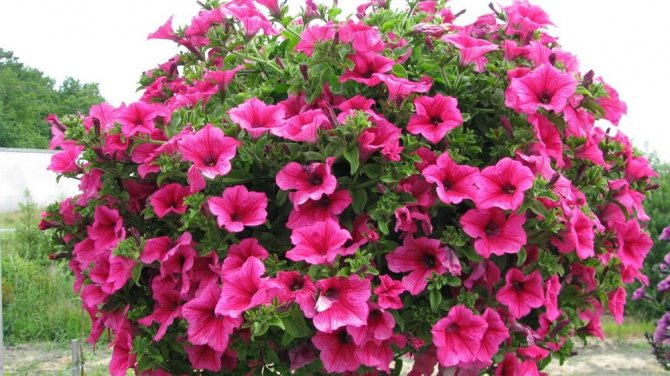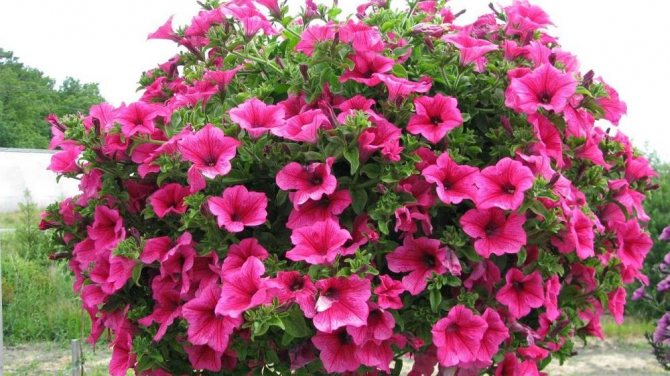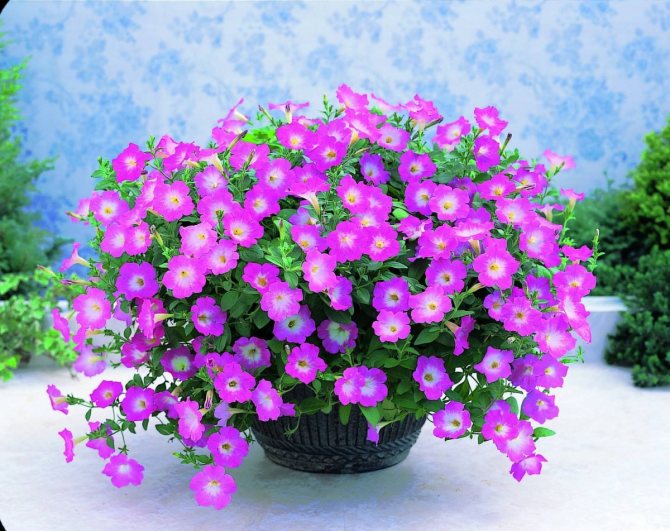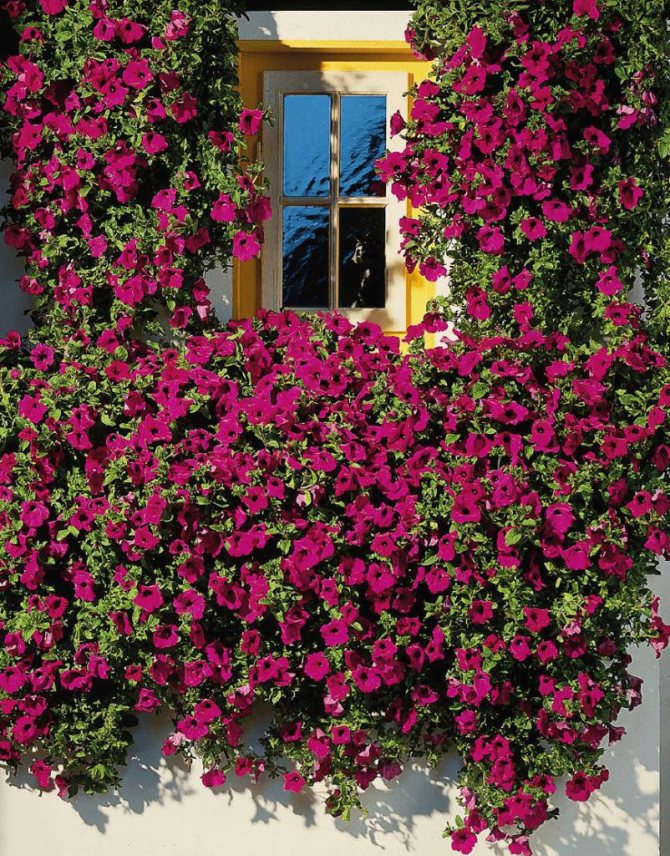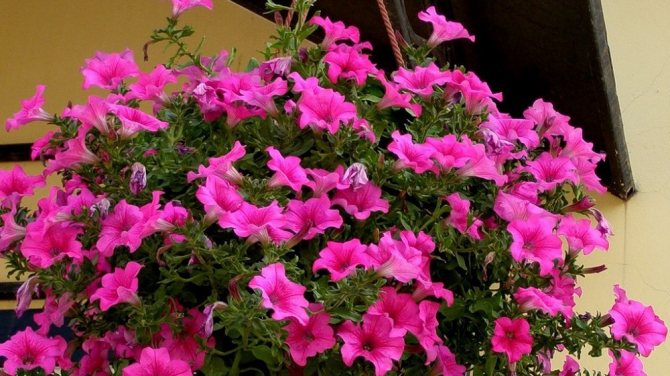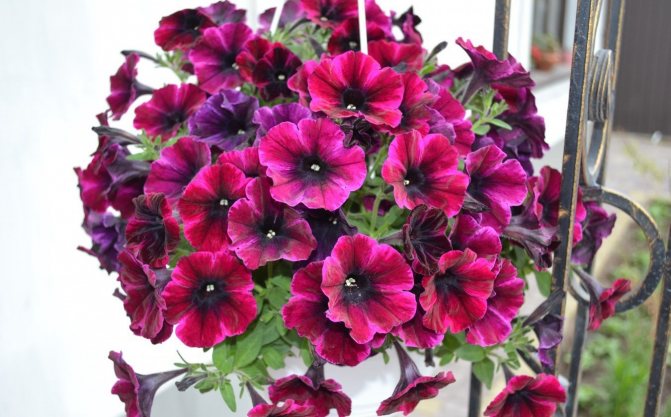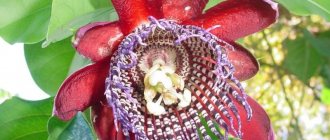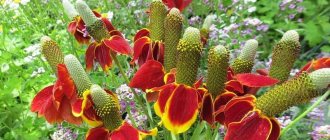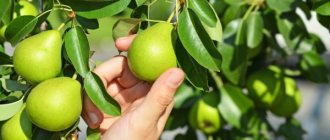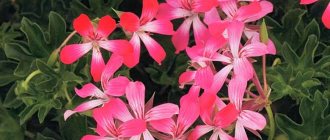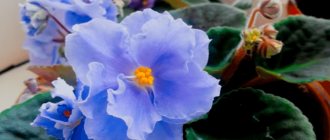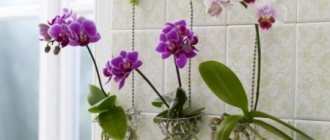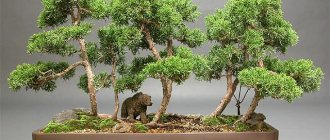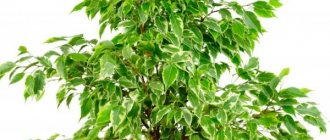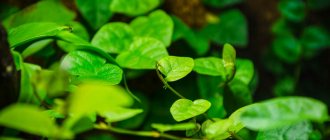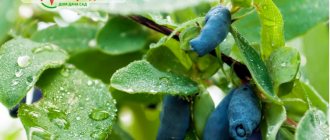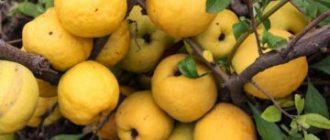One of the varieties of ampelous petunias is surfiniya. The plant is so bright and extraordinary that it has become a household name for numerous hybrid forms of an annual weaving. This is often used by cunning sellers of flower seedlings, who sell everything that is more or less woven under a popular brand. What real surfiniia looks like, and why all the fuss - let's figure it out together.
Plant varieties with photos
More than twenty types of surfinias are popular among flower growers, many of which also have well-known varieties. Some of them are a little more detailed.
Surfinia ampelous
This is the general name for the perennial species grown in the garden. Shoots without leaves hibernate in basements, and as spring approaches, leaves and buds appear on them.
Surfinia Elow
One of the first breeding works to breed ampel petunias. It blooms with pale yellow flowers early and generously until frost.
Surfinia Burgundy
A branchy bush in abundance strewn with flowers of the rich shade of the wine of the same name. Pleasing for several months.
Surfinia Double Purple
Complex flowers with a bright purple hue. Refers to fast-growing varieties that tolerate high humidity in summer. Shoots can go down a meter with a twenty-centimeter bush growth.
Surfinia Hot Pink
This species is characterized by the large size of flowers in two shades: crimson stripes stand out brightly against a pink background. They run from the middle to a wavy border along its edges.
Surfinia Table White
This is an early type of surfinia with flowering lasting almost six months. He is also loved for the snow-white shade of flowers that resemble bells, and their abundance on the bushes.
Surfinia Red
These are spherical, miniature bushes, covered with bright red flowers. The flowering is early and long-lasting, but the variety is rather capricious in its care.
Transfer
The cultivation of surfinia involves a transplant. It may only be required if normal growth is impaired. This situation occurs when the soil is waterlogged and the appearance of a fungus. Sometimes it may be necessary to replace the soil with a more nutritious and loose one, if initially it was not.
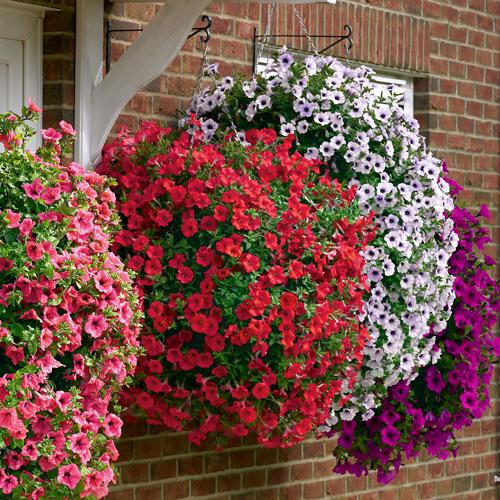
Transplanting is best done in the spring. However, if necessary, this procedure can be performed at other times. To do this, you need to pick up a new pot. A layer of expanded clay is laid on its bottom.
After that, you need to get the plant out of the old container. The roots are shaken off the soil carefully so as not to damage them. Next, you need to inspect the plant. If there are roots with defects, rot, they are carefully removed with a knife. Places of cuts must be treated with activated carbon and dried a little.
After such manipulations, the surfinia is moved to a new pot and the roots are sprinkled with earth. The soil needs to be pressed a little, compacting it. The plant is watered and left in a lighted, warm place. Adaptation to new conditions takes 2-3 weeks. Then the shoots will grow again, new buds will bloom on them.
Surfinia and petunia what is the difference
Surfinia is one of the nine species of the petunia family, in fact, it is a hybrid of it. This subtlety can only be distinguished by specialists, novice florists confuse them. Its advantages in relation to the mother plant:
- high resistance to negative weather conditions: rain and wind;
- early, long and abundant flowering with many shades and varietal diversity;
- low susceptibility to diseases and pests;
- accelerated vegetation.
Interestingly, surfiniya manages to form into a full-fledged plant with almost six months of flowering in a couple of months.
Watering and lighting
The process of growing surfiniya from seeds at home is relatively straightforward. It is necessary after planting in the ground to provide sufficient lighting for the plant. Proper watering is also essential. If the seedlings do not receive enough light, they will weaken. Many buds will not form on the shoots.
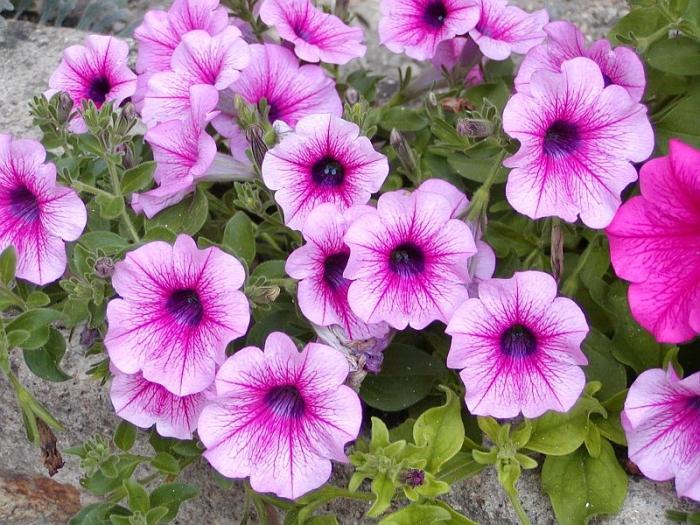

For surfinia to feel good, it needs to receive light for at least 10 hours. Therefore, quite often the plant does not have enough natural light. You will need to create artificial lighting in the evening.
In order for the plant to develop correctly, it is required to provide abundant watering of the surfinia. Cultivation and care require a certain amount of attention from the gardener. Surfinia requires regular and abundant watering. At the same time, the culture is quite drought tolerant. In the summer months, the root system grows strongly. It requires a sufficient amount of moisture.
Watering the surfinia is necessary often if dry, hot weather is established. On such days, you need to irrigate the soil twice a day. However, waterlogging should not be allowed. Otherwise, the roots will rot. This can lead to the death of surfinia.
Necessary conditions for growing surfiniya
How to preserve surfini in winter? In the middle lane, perennial surfacing in winter can only be preserved indoors. After flowering, almost all shoots are cut off, leaving twenty-centimeter fragments with leaves. Vases are placed on a warmed veranda, where there is enough light. Water it occasionally to keep the earth from drying out.
By the end of winter, the plants begin to come to life. It is important that the temperature in the room does not fall below plus five degrees. Plants in early spring need good lighting.
How to plant surfiniya
At home, the cultivation of surfinia begins with sowing seeds or cuttings. These methods are a valid alternative to the brood culture described above.
Selection, selection of seeds and planting
For sowing, choose fresh seeds, the shelf life of which has not expired. Plated copies are stored less than usual. The suitability of the seed can be judged by the instructions on the package.
Sowing seeds is carried out in early spring according to the following scheme:
- Prepare a container with light earth that is freely permeable to air and water. It can be peat with sand or peat pellets. At the bottom, there must be a drainage layer of small pebbles or foam balls.
- The seeds are too small. They are sown in several pieces on a pre-moistened surface, without falling asleep with earth, and covered with a film or transparent glass.
- Irrigation is done from a spray bottle, preventing the soil from drying out, and the improvised greenhouse is also regularly ventilated.
- The pots are placed in a warm, well-lit room, warmed up to 20 degrees. But the crops should not be exposed to direct rays of the sun.
- After a couple of weeks, when the first shoots appear, then the roots are sprinkled with calcined sand. This strengthens and protects against decay. By that time, there is no need for greenhouses. After a while, sand is poured onto the seedlings again.
- For plants with two leaves, a pick is carried out. They are seated one by one in separate containers. When growing seedlings in peat tablets, there is no need for picking.
Surfinia cuttings
Surfinia are often propagated by cuttings. A large specimen is cut in early autumn. It is immediately planted in fertile soil.The seedling is covered with a film or a greenhouse from a glass jar and placed in a warm and bright place. Don't forget to water your plant regularly. In this case, the soil must be drained and not retain excess moisture.
With the appearance of new leaves on the plant, the greenhouse is removed. The temperature when grafting surfinia should not fall below 20 degrees. By mid-spring, a viable young shrub will be formed, which can soon be placed in a permanent place where it will bloom profusely.
Seedling care
Surfinia is a photophilous plant, therefore, good lighting of the seedlings and, as necessary, artificial lighting without direct sunlight provides further abundant flowering of the bush.
With the appearance of several leaves on the seedlings, the bushes are pinched with the removal of the upper pair of leaves. This stimulates the appearance of lateral cuttings and allows for a branchy and lush bush.
By the end of spring, they are ready for planting in open ground. Seedlings begin to feed three weeks after the first shoots, combining with watering. The initial concentration of a complex fertilizer with a predominance of potassium is weaker than that indicated in the instructions, and then it increases to normal. Feeding is carried out at two-week intervals.
Reference. When planting seedlings in pots or flower beds, it is best to combine plants with contrasting colors to create a colorful picture. You can also alternate colors in a specific sequence.
Where is it better to grow surfinia
Surfinia does not like shading and needs sunlight for growth and abundant flowering. It is also not desirable that the pots with a flower hang from the leeward side. Otherwise, long shoots with bright flowers will constantly get confused by the gusts of the wind.
The plant feels great on the sunny side, where there is no thick shade and drafts. It is advisable that the pots are protected by a canopy from rain drops on the flowers. Ideally, the sun will illuminate the plants in the morning, and then they would be slightly shaded.
Soil and lighting requirements
All members of the petunia family love sunlight. If the seedlings do not have enough light, then the sprouts are weak with a small number of flower buds. The duration of daylight hours should not be less than 10 hours, so plants need illumination in the evening.
The ideal soil for growing surfinia is loam with a pH of 5-6, it also applies well to sandy soils. The plant adapts perfectly to any fertile substrate. For normal growth, he needs a spacious pot.
Important! Humus, especially fresh, should not be introduced when planting surfinia.
How to properly plant in open ground, we carry out the hardening of surfinia
Before relocating surfiniya to a flower bed, the plant is hardened. A few days before, the seedling is taken out in the middle of the day for a couple of hours to adapt to the garden. They do this at the end of May.
Young plants are planted in the soil of the same composition where they were before. You can add hydrogel or perlite there. The ampelous plant looks beautiful in balcony boxes or in hanging pots with side holes.
Caution! In case of prolonged rains, it is better to bring the plants under a roof or cover with foil, otherwise large raindrops can damage the delicate petals.
Care during the flowering season
During the flowering season, three points are important for surfinia: adequate lighting, constant watering, and regular feeding.... Then she will bring joy with an abundance of delicate, fragrant flowers of bright colors. It is also important that the bushes on the flowerbed do not suppress the weeds, and they have enough room for growth.
Rules and requirements for watering and feeding plants
Daily watering is a prerequisite for good surfinia development. But she needs a small amount of water: it is better to water more often, but not pour.It is also good to spray hanging flowerpots from a spray bottle. The water should be settled and not cold. In the heat, it is better not to water the flowers, but to do it in the morning and evening.
Delicate flowers need periodic feeding. Bushes need potassium for better flowering.... Top dressing with special ready-made compounds for flowering plants is done twice a week, combining them with watering. The same rule is observed as when watering: more often, but in a smaller amount.
Planting and grooming secrets
Surfinia, being a type of ampelous petunia, has in many ways similar cultivation and care techniques. And what is the disappointment of flower growers when, after a couple of weeks of intense flowering, the plant suddenly stops growing and loses its decorative effect. To prevent this from happening, we will share some of the features of the cultivation of a weaving annual.
Planting seedlings
In the hybrids of this variety series, there is initially a great growth potential, therefore, they need intensive nutrition and large volumes of soil. The more soil, the more powerful the root system, therefore, the seedling more actively builds up its vegetative mass.
If you plant surfinia in a container, one plant should have at least 5 liters of volume. Do not plant more than 3-4 plants in a flowerpot with a capacity of 30 liters.
The soil should be light, loose, fertile. When planting, it is advisable to use professional long-acting fertilizers. These are capsules or granules that will dissolve under the influence of moisture throughout the season, enriching the soil with the necessary elements. But for continuous abundant flowering, these fertilizers are not enough.
In hot climates, hydrogel, balls that retain moisture, can be added to the planting substrate.
Top dressing
Surfinia (sulfinia) loves to eat, so one of the secrets of care is associated with regular feeding.
Liquid dressings are most effective. They are prepared from organic or mineral fertilizers by dissolving in water. The frequency is once a week.
Immediately after planting, fertilizers are used in which there is a lot of nitrogen, including organic matter. Nitrogen is necessary for the rapid growth of shoots, branching. Phosphorus is also important - it will help form a strong root system.
With the appearance of the first buds and until the end of flowering, surfinias are added with complex fertilizers based on phosphorus and potassium. Examples of suitable formulations are Kemira Lux, Agricola, Plantofol, Crystalon, etc.
Sometimes, to increase the intensity of flowering, enlargement of the flower, growth stimulants are used, such as Epin, Zircon.
Surfinia, planted in a flower bed, especially if the soil is fertile, does not need such frequent feeding. It is enough to do this 3-4 times a season. Better yet, look at the state of the plant.
Watering
Watering ampelous flowers is necessary often, preventing the soil coma from drying out. In the heat, besides watering, spraying is important. Use a fine spray to prevent the water jet from damaging the delicate petals.
Main characteristics
Surfinia ampelous is one of the most spectacular types of petunias, which can transform a balcony or garden beyond recognition. thorium origin goes back to the 90s, when complex breeding work was carried out to breed a hybrid. The new variety distinguished itself from its close relatives by its ability to maintain a delightful flowering even after heavy rain. By comparison, common varieties begin to shed flowers. Also surfinia is characterized by excellent immunity, which allows her to easily transfer various diseases and contact with pests.
Under favorable conditions, the culture grows up to two meters, and its flowers have a diameter of two to seven centimeters (depending on the selected variety). The flowers are funnel-shaped in shape, with clearly defined segments.The color of the petals is determined by varietal properties and is either monochromatic or multi-colored. There are varieties with simple and double flowers. The leaves and stems are light green in color and have a fleecy surface. Small leaves have a pronounced central vein and are sparsely placed on the stems.
Winter care
In winter, surfinia has a dormant period. The plant must be prepared for this. In the fall, you need to shorten the shoots. They should be no more than 20 cm long. If the plant was planted in a flower bed, you need to dig it up and transplant it into a flowerpot. It is left in a cool room, where the temperature will not drop below +5 ºС.
It is necessary to wrap a flowerpot with a plant so that the roots feel comfortable during wintering. Fertilizers left over from the summer should remain in the soil. If the plant was transplanted from a flower bed, dry complex top dressing is applied to the soil. Surfinia should overwinter in a bright room. From time to time, the soil will need to be watered.
Before taking the plant out into the street in the spring, the culture will need to be prepared for this, that is, hardened. To do this, the container is taken out into the street for several hours. Then the interval of her stay in the fresh air is increased. During hardening, you need to ensure that direct sunlight does not fall on the leaves and shoots. After 2-3 weeks of such adaptation, it will be possible to plant the plant in the ground or leave it in a flowerpot in the fresh air all the time.
Varietal variety
Currently, the Japanese company Suntory, which is considered the ancestor of surfiniya hybrids, offers a wide variety of varieties with different shapes, flower colors and sizes.
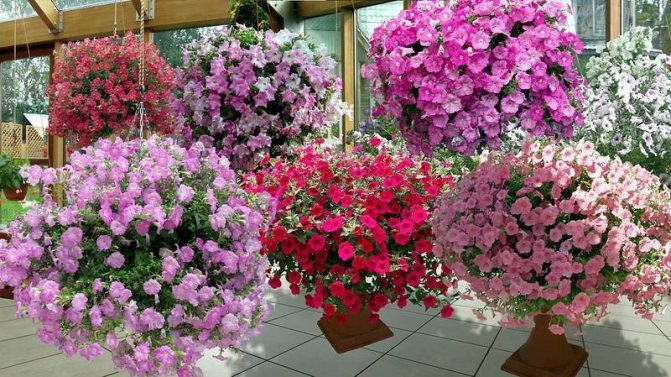

Each of them may be interesting for a particular grower.:
- The classic varieties of surfinia flower include early flowering species that can form powerful shrubs with long stems and many flowers. The shape of the latter remains characteristic of the traditional form of petunias. The differences in flower color are highlighted by the names: Surfinia White, Surfinia Red, Blue, etc.
- The Table series is characterized by abundant flowering and the shape of compact ampelous or semi-ampelous bushes. The flowers resemble small bells in shape.
- Representatives of the Double varieties have large double flowers and are considered the most decorative. However, their flowering is not as lush and abundant as in previous species.
- The Specials series includes the latest developments with unusual colors and a number of other unique properties. For example, Surfinia Amethyst is able to form a lush green cap that does not need additional trimming. The incredible aroma from the flowering plant will be heard from a distance of several meters.
Varieties of surfinia and its close relatives
To plunge deeper into the topic, we offer a selection of varieties of classic surfinia with photos and descriptions. And also some interesting hybrids very close to her.
- Velvet Blue is a bright classic representative of the variety series. The gramophone is not very large, but of an interesting shape - with wavy, like velvet petals. The bush is literally dotted with them. The pharynx is small, light, because of this, the entire flower looks completely purple.
- Burgundy - the name reflects the rich wine (burgundy) color of the flower. The variety is distinguished by a massive, actively branching, but at the same time compact bush, evenly developing in all directions. The flower is large, up to 8 cm in diameter. In addition to hanging pots, it feels great in a carpet flower bed.
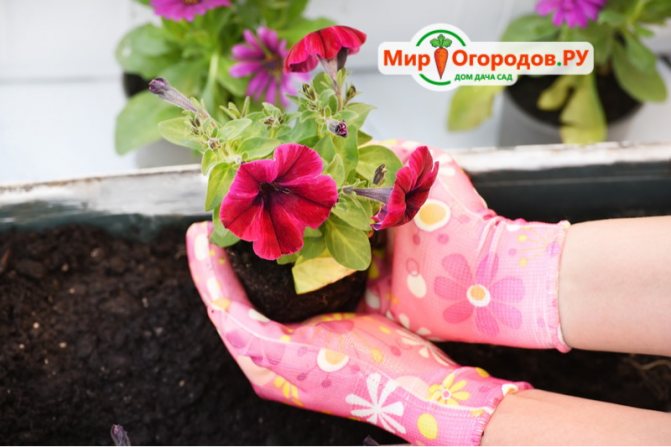

- Deep Red is an award-winning variety, laureate of many flower exhibitions. This pure, deep red is a rarity among petunias. Propagated only by cuttings. If he sets seeds, the plants from them turn out to be little similar to the mother.
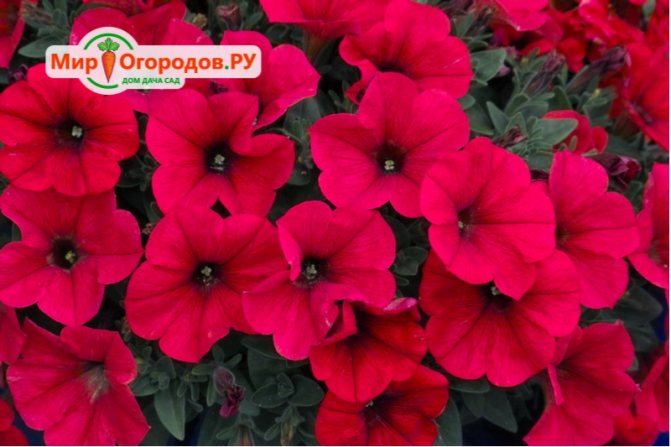

- Hot Pink is a compact medium-sized surfiniya with large flowers. The variety has a very pleasant juicy pink color with a burgundy throat.From the depths of the phonograph, crimson veins spread along the petals, adding volume and texture to the flower.
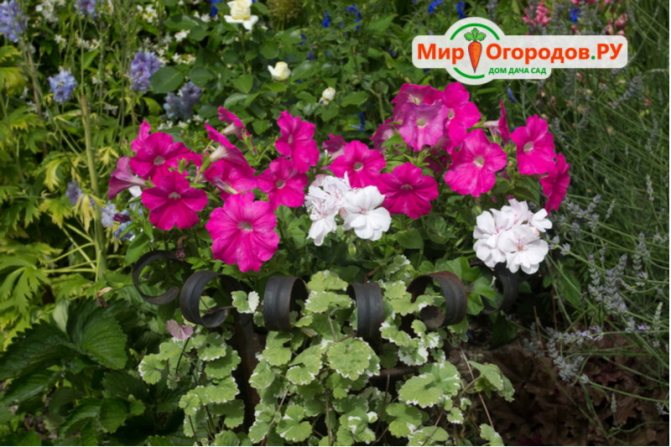

- White is a strongly and actively developing plant that grows lashes up to one and a half meters, with a dense head of flowers, which makes it in demand for cascading flower beds. The flower is medium-sized, snow-white with a pale yellow core.
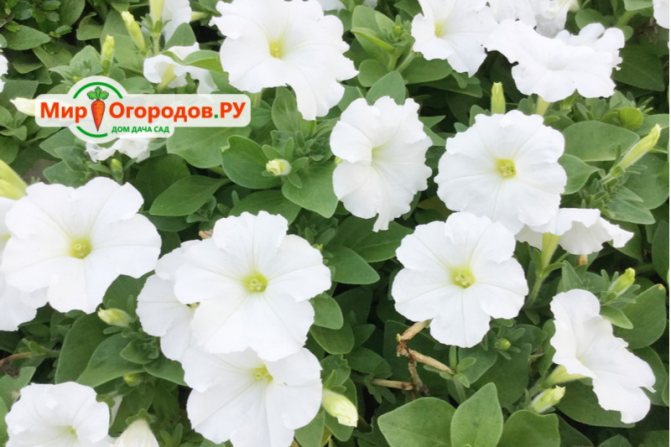

- Tumbelina Suzanne is a close relative of ampelous surfinia, but belongs to a different variety group - Tumbelina. The plant is so unusual and graceful that you won't immediately tell that it is a petunia. The indisputable dignity of Suzanne is the large double flowers of a delicate cream shade. The hybrid is rare, propagates only by cuttings.
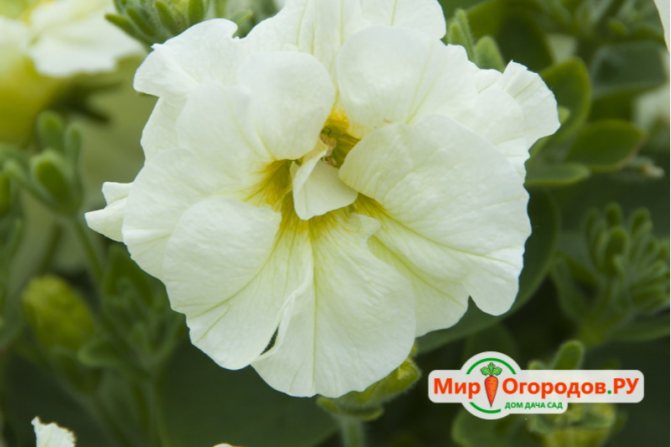

- Green Edge Pink is a new original variety with an unusual color - pink, like ruffled petals along the edge are framed with a light green border. The bush itself is compact, evenly developed, dense. There are so many flowers that the leaves are almost invisible. The formation, pinching of the lashes does not need.
- Giant Purpl is a vigorous, vigorous plant with large flowers up to 10 cm in diameter. The eye is attracted by the rich dark crimson color of the flower cup with an almost black pharynx. The composition looks very stylish and sophisticated.
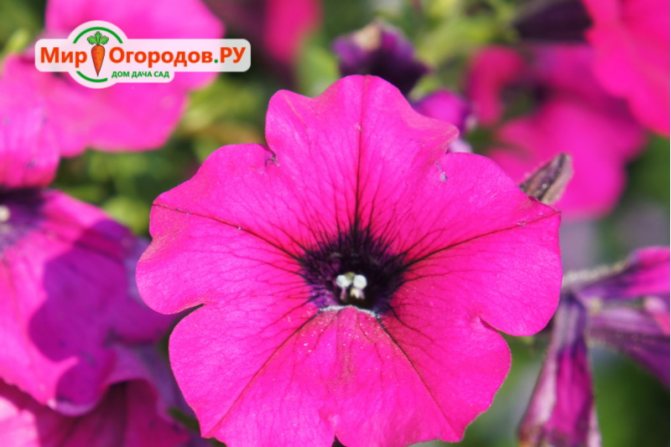

Surfinia care
Every self-respecting florist should know how to grow a colorful flower at home. After all, the decorative properties of this plant are so high that it should be present on every balcony, loggia or in a garden on a flower bed.
And so that home cultivation brings the expected success, it is important to take into account a number of basic requirements and conditions in which the flower grows best:
- Being a prominent representative of the tropical flora, surfiniya needs abundant sunlight and warmth. Therefore, when choosing a place for planting or placing hanging pots, it is advisable to choose the most illuminated points. Special attention is not paid to the quality and composition of the soil, since in this regard, surfiniia is unpretentious. Experienced flower growers recommend planting it in loose and light soil, which is pre-treated with organic fertilizers, for example, compost or humus. Also, the substrate must have a good drainage system, since stagnant moisture in the pot can have a detrimental effect on the crop. A thick drainage layer is placed in the pot just before planting. You can buy ready-made potting soil at a florist shop.
- Watering the plant must be taken with full responsibility, especially if surfiniia grows in pots or hanging pots. It is important to avoid drying out the upper layers of the earthen coma, but also to prevent moisture stagnation. It is no secret that surfinia roots are very thin, so prolonged drought can damage them and lead to wilting of the entire plant. In the dry summer season, watering can be done three times a day.
- To achieve good branching of the plant, you can pinch the top of it. After this procedure, the petunia will stop blooming for about 3-4 weeks, but then the flowering will become abundant again. To maintain the decorative and neat appearance of the bush, it is important to regularly clean it of faded flowers and dried leaves.
- Suitable fertilizers are applied to the soil every week. In their capacity, complex formulations can be used, which are sold in specialized retail outlets and contain a minimum amount of nitrogen-containing additives. In addition to root dressings, from time to time, external ones are used for spraying the leaves.
Care
Watering
Moisten the soil regularly and in a timely manner. And although the plant tolerates drought well, during periods of extreme heat, overgrown roots require an abundant amount of water.
Important! Watering is carried out strictly at the root. But only do this after the topsoil dries out.
To prevent drying out of the earth in the container, mulch.
Top dressing
Surfinia responds positively to feeding.When applied regularly, it will repay with bright and beautiful flowering. Add nutrient formulations once every 7-10 days. An infusion of mullein or vermistim is suitable for this.
Growing from seeds
Among the various methods of reproduction of surfinia, growing from seeds is considered the most popular. This is due to the simplicity of the procedure and the high germination rate. High-quality planting material can be collected directly from home bushes or bought at a florist's stall. In the latter case, ordinary and pelleted seeds are offered. If the former give poor shoots due to low quality, the latter need moderate watering from the moment of planting, otherwise their shell will not be able to finally open up.
Only fresh raw materials are suitable for sowing in the soil, therefore, at the acquisition stage, attention should be paid to the storage periods and the method of planting different types of seeds. The coated version is more demanding in terms of conditions of detention and timing.
To plant a crop, you should follow these steps:
- Prepare a pot with light and loose soil that can allow water and air to pass through. Peat, which is pre-mixed with sand, as well as peat pellets can be used as a filler.
- It is no secret that the size of surfinia seeds is relatively small, so it is customary to sow them on the surface without sprinkling them with an earthen clod on top. At the same time, a comfortable greenhouse is set up above the seedlings, for example, made of plastic film or glass.
- A spray bottle is used to water young plants. Also, at an early stage of their development, periodic ventilation is required. The bottom of the container used must allow water to pass through, otherwise moisture stagnation will entail not the most pleasant consequences. Excess water should not accumulate at the bottom, but, on the contrary, calmly come out.
- The container with seedlings should be in a warm, well-lit room with a temperature range of 20-22 degrees Celsius. It is important to protect the surfactant from direct sunlight.
- If the previous steps are performed correctly, it means that the first shoots should hatch in 14 days. At this time, it is required to add a small amount of river sand to the container, which will protect the plants from root rot and become additional stimulation for their growth. As soon as the seedlings grow a little, the procedure can be repeated.
Gentle doesn't mean weak
The appearance of a flower is deceiving. As graceful and gentle as he is, he is also strong. In favorable conditions, with an abundance of heat and moisture, in 2 months the surfiniya flower grows so that sometimes two-meter stems take up a lot of space in the garden. Knowledgeable people plant plants higher or farther from each other.
Lateral shoots on the stems grow from each internode, and the more there are, the thicker the plant's cap will be and the richer the abundance of flowers. Thus, the vegetative mass is increased. It comes in different forms:
- ball;
- pillows;
- cascade.
It all depends on the imagination and method of planting by the gardener.
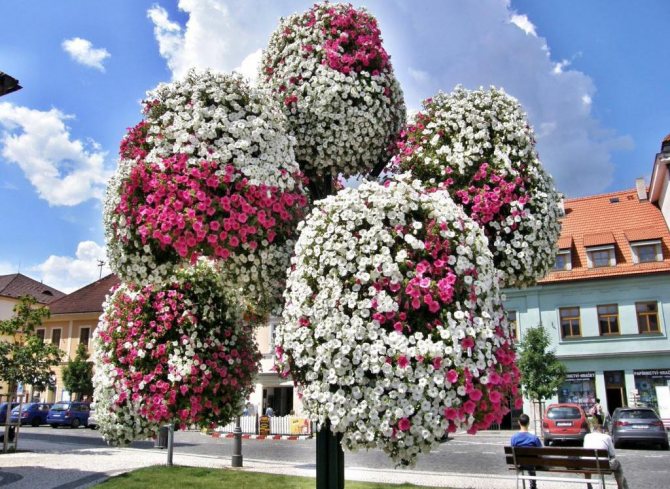

Surfinia boasts not only the beauty and abundance of shoots, its root system can only be envied. It is very strong and branched. For normal growth and nutrition, one seedling will require at least 5, or even 7 liters of soil.
Planting tips
As for the picking, it is carried out for those plants that already have two full-fledged leaves. At this stage, they must be transferred to larger pots and placed in such a way that neighboring young specimens do not disturb their growth. When growing seedlings in peat tablets, diving is not necessary, since each seedling is placed in a separate plate.
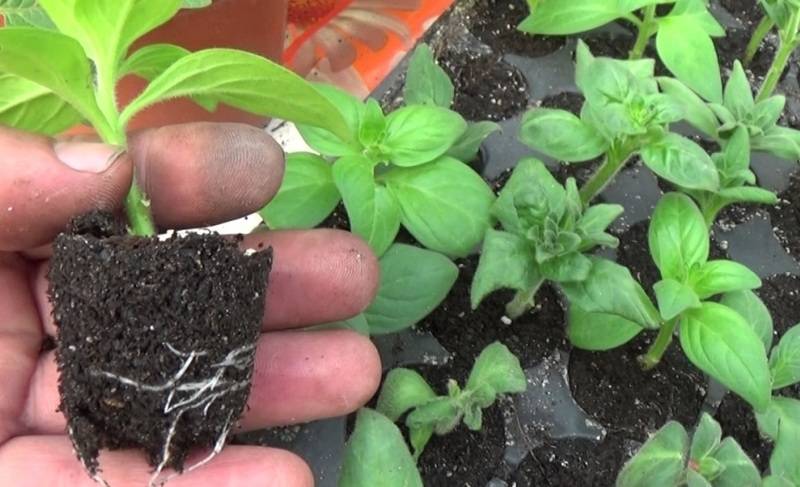

If the plant lets out 5-7 adult leaves, and the root system becomes strong enough, it can be moved to open ground, to a flower bed or hanging planter, to a balcony or terrace.
At the same time, the florist can realize his imagination and carry out combinations with different colors and shapes of the bushes, creating more saturated ensembles. Seedling seeds placed in the ground at the end of March - beginning of April... If planting is carried out in open soil, then it is important to make sure that the air temperature is consistently high, and the soil warms up by 3-4 centimeters. As a rule, this happens in late May - early June.
During this period, seedlings are regularly fed. Top dressing is started after 3-4 weeks from the moment the first shoots are pecked, applying fertilizers to the ground along with water.
Complex compositions for flowers with a weak concentration are used. As the culture develops, the concentration is increased.
How to distinguish from petunia?
The beautiful annual plants of the ampelous type include petunia and surfinia. What is the difference between these beauties? The differences are noted for the following features:
- At the seedling stage, flowers are distinguished by their ability to branch and grow. Even at the level of sprouts, it was noticed that the seedlings of petunias are much smaller than the seedlings of surfinia, although they are of the same age. Petunias have a meager number of side shoots, compared to surfinia. Petunia shoots tend upward. Surfinia has a lot of shoots; in pots, at first they grow to the sides and resemble a giant colorful spider, then they hang down in garlands.
- Here's another difference - petunia and surfinia, as adult plants, form their bush in different ways. To grow a luxurious crown of petunia flowers, a person should come to the rescue. It is required to pinch the shoots that have grown on the sides, thus activating branching. First, the plant should be green, and only then bloom. Only in this way, and not otherwise, you will get a beautiful green petunia hat, decorated with flowers. With surfinia, things are easier. She herself will direct her processes, and the space allotted to her will be filled with flowers and their aroma.
- Although relatives and close ones, their breeding method is far from each other. Petunia can be propagated by cuttings and produces seeds. Surfinia for seeds is "greedy", so the vegetative method is used for reproduction. It is enough just to cut the cutting off the bush and transplant it into the ground. In order for the stalk to take root, this must be done faster.
- What is the difference between petunia and surfinia yet? They can be compared by the bushes and flowers themselves. Petunia is a small plant that usually grows in boxes on balconies or lawns. Surfinia has a more lush and rich flowering, it is planted in large baskets and outdoor flowerpots, at a good distance from each other.


Despite the exquisite beauty of surfinias, petunias should not be discounted. Breeders have developed new mini-varieties that will delight the eye and decorate the summer cottage with their flowering. The species with amber flowers is in demand. Unlike a simple petunia, it will compete even with surfinia.
In addition to the indicated signs, it will not work to find what is the difference between surfinia and petunia, since it is no longer there. They have similar flower shapes, sizes and color palettes.
Diseases and pests
When it comes to growing surfiniya hybrids, there is practically no risk of developing diseases. However, non-compliance with the basic rules of care, excessive watering or other factors can lead to the formation of white rot or black legs. Unfortunately, there are no effective methods of combating these diseases, therefore, in most cases, the bush dies. If symptoms of an illness appear, it is recommended to remove surfin from the garden to avoid contamination of other, healthy plants.
Of the pests, the main enemies are thrips, whitefly and spider mites... To overcome these pests, it is enough to carry out a complex treatment of the bushes with a solution of soap two to three times with an interval of 3-5 days. If there is no positive result from such a procedure, you will have to introduce special means to eliminate parasites.
To prevent the development of disease or pest damage, surfinia must be constantly monitored. It is important to consider the condition of the soil and the placement of the crop in the garden or balcony.
A spider mite can also infect a hybrid petunia. Traces of the parasite's vital activity appear in the form of light spots on the leaves with characteristic yellow dots from bites. Over time, the leaves begin to dry and a kind of thin web appears on them.
Ways to combat may consist in the use of effective drugs Nero or Apollo. Traditional insecticides, which are excellent at fighting other pests, are simply powerless.
If the culture is affected by thrips, then this will be emphasized by the necrosis of the affected tissues. Also, against the background of the dried out areas, placers of small dark excrement will appear, which will leave the larvae of the parasite.
To combat thrips, the chemical agent Aktara or Intvair is used. Timely handling is the key to successfully dealing with the problem.
Sometimes whitefly affects surfinia. In this case, the leaves begin to turn yellow and wither. If you touch the affected areas, then the tiny pests will begin to scatter to the sides and hide in the lower part of the leaves of neighboring plants. To get rid of the whitefly, you can use glue traps or complex treatment with biological products. If this does not give the expected success, chemicals will have to be introduced.
Possible problems
When growing surfinia, the following problems are possible:
- Stopping growth, no flowering. The main reason is the lack of lighting. To do this, you need to install the petunia on a saucer with diffused light, and in winter, supplement the flower with lamps. In addition, a stop in growth is possible when tying up petunia branches.
- Decay of roots. This problem is one of the most common. Its main reason is an excess of moisture. Petunias love the alternation of drought and complete saturation of the soil. Water the plant every day only if it grows in the country or on a sunny windowsill. If the black leg is affected, use Fitosporin.
- Burns on the leaves. They are formed mainly due to improper feeding. It is better to do this in cloudy weather. You do not need to immediately put the plant under the lamp, you need to wait for all the spray to be absorbed into the leaves.
Petunia Surfinia is an amazing flower that amazes with the beauty of its bloom. In addition, it is completely easy to take care of him, since all the events are standard. Even a beginner can cope with all the work, so this is an excellent choice for those who are just starting their acquaintance with petunias.
Other varieties of ampel, cascading, bush and undersized petunias of a wide variety of colors are no less popular. Among them, the most widespread are: Opera, La Gioconda, Tidal, Starry Sky and Grandiflora.
Application methods
There are quite a few ways to use surfinia in home floriculture. As a rule, they decorate terraces, balconies, gazebos and houses with it, placing them in hanging pots. Often flowering waterfalls from this hybrid petunia decorate city streets in old districts of European cities. Also, bright compositions are present in the decorations of outdoor cafes and restaurant areas.
Cultivating a culture at home is a great way to transform your landscape or façade design, as well as highlight your high taste preferences. And given the simplicity of caring for the culture, its unpretentiousness to the conditions of detention and other advantages, such an activity brings only positive emotions.
The main thing is not to forget about the basic rules of planting and provide the plant with proper care. In this case, the time and effort spent will pay off in the form of abundant flowering.
Outdoor cultivation
Surfinia can be grown outdoors or in a flowerpot. If you plan to plant a flower in a flower bed, you need to pick up a site with fertile soil. However, on soils such as loam or sandy loam, surfiniya also grows well if the soil is mixed with compost beforehand.
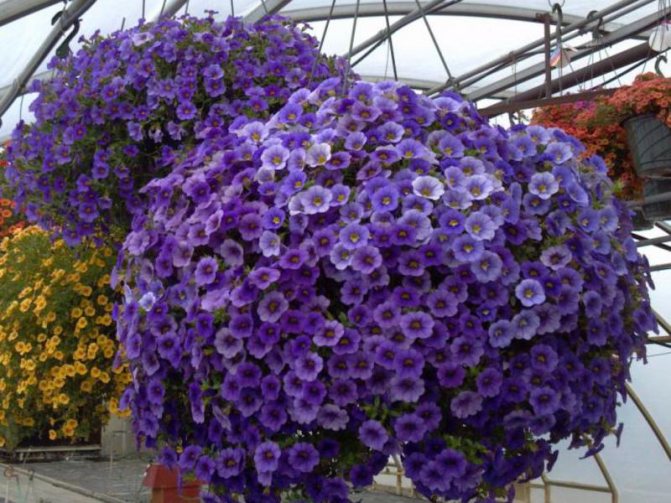

Acidic soils are not suitable for the growth of this plant. Before planting, you need to mix the soil with lime (add 300 g per square meter of the bed). In addition, the soil should be lightweight. Loose and moisture-absorbing soils are ideal for growing surfinia.
The plant requires the creation of drainage. This is necessary in order to prevent root decay. This layer should be at least 5 cm.
Young plants are obtained mainly from seeds. In this case, the cultivation of surfinia is carried out by the greenhouse method. The process starts in February. The first shoots will appear in 2 weeks. Next, they will need to dive into different pots. Plants are planted in open ground at the stage when the plant has 5-7 true leaves. This usually occurs in mid-April, when the chance of frost will be ruled out.
Description
Surfinia is one of the varieties of ampel petunias. Its abundant, dazzling, lush bloom is misleading to many growers who grow it. Most varieties are distinguished by an ultra-fast growing season and in 1.5-2 months they completely form a bush, begin flowering, which lasts until frost. Surfinia has its own characteristics that distinguish it from any other hanging and ground cover type of petunias:
- The bushes have flexible, long, up to two meters, stems covered with a spectacular cascade of flowers;
- Flowers are large, simple or semi-double, reaching 5-6 cm in diameter;
- The color of the flowers is varied;
- Flowering in indoor conditions and in warm climates is long, abundant, begins from the end of April to the first cool autumn days, when the temperature is still + 10-15 ° C.
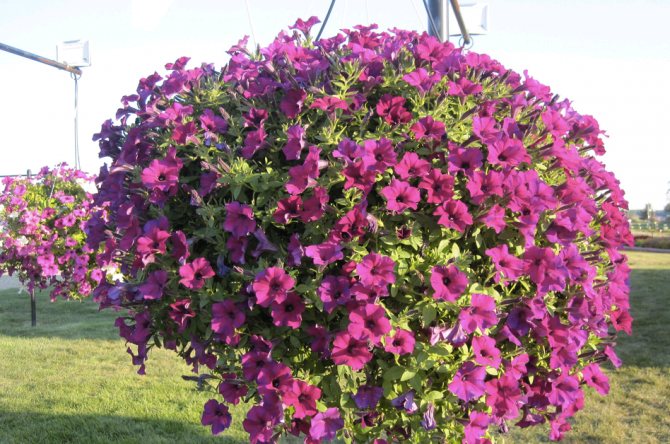

Important. The plant is highly resistant to extreme weather conditions. It tolerates hot sunny days and cool heavy showers well.
In recent years, it is difficult to find simple types of petunias. Increasingly, flower beds are decorated with petunias with large flowers reaching up to 10-13 in diameter.
The bred varieties of ampelous surfinia, its lush flowering, prompted breeders to create new species.
Today, surfinia varieties have appeared with a new shape of bushes, flowers and a new variety of colors:
- The bush of the plant has straight stems;
- Flowers are smaller, up to 2.5-4 cm in diameter;
- The color of the flowers is distinguished by bright colors with veins of various shades. Appeared in the assortment of yellow surfinii.
The daughter who surpassed her parents
Surfinia (in another reading - sulfinium) is the brainchild of Japanese breeders. In the 70s of the last century, Suntory was trying to adapt large-flowered petunias to unfavorable weather conditions by means of cell hybridization. The result of the work was an ampelous variety of a flower, which could only be propagated by cuttings to preserve uterine characteristics. He did not give seeds. The plant was registered under the Surfinia trademark and gained worldwide fame in a short period of time. What is the secret of such popularity?
Bright, but not simple
Beauty is not uncommon for members of this flower family. In some varieties, it is refined, aristocratic, in others it is catchy, one might say, gypsy.
Surfinia is by no means a simpleton. Large gramophones of flowers with a diameter of up to 9 cm are distinguished by a clean, rich color, against which a darker pharynx stands out. Sometimes the petals are beautifully traced by contrasting veins or framed by a white border. These are the first, classic varieties.
The variety series of ampelous Surfinia Double (double) amazes with thick double flowers of incredible shades.Hybrids with the Mini prefix are a cascade of miniature (ø 5–5.5 cm), but very expressive phonographs.
Heroic strength
Behind the exquisite appearance of our heroine there is a remarkable strength of growth and resilience. In warm, humid weather and sufficient nutrition for 1.5-2 months, it forms powerful branched whip-garlands up to 2 m long. Moreover, lateral shoots develop literally from each internode, increasing the vegetative mass in the form of a ball, pillow, cascade - it depends on the method planting a plant.
Note! A large vegetative mass and continuous abundant flowering of surfinia are supported by a powerful root system. To provide the plant with food, one seedling requires at least 5–7 liters of soil. If the flowerpots are small, it is better to plant compact hybrids of ampel petunias.
Neither rain nor wind is terrible
The most serious minus of petunias, including some ampel varieties, is instability to bad weather. The petals of the plant are so delicate that the wind literally tears them, and the rain turns them into a shapeless mass. In the literature, advice is often found - during the rain, hide flowerpots, pots with flowering annuals under a canopy. But this is extremely inconvenient!
Surfinia ampelous is devoid of this drawback. It does not need to be hidden, the maximum that should be done is to remove the flowers spoiled by moisture. Very quickly, the plant will replace them with others without compromising the appearance.
So, we can see the features of an ideal ampelous plant. The main thing now is not to confuse her with close relatives.
How to distinguish from ampelous petunia?
Let's compare surfinia and petunia, and determine what is the difference between them.
- At the seedling stage, plants are distinguished by their vigor of growth and the ability to branch. Surfinia seedlings are larger in comparison with petunias of the same age. Lateral shoots of petunia are not so numerous, grow upwards. Surfinia develops as a "spider" - it gives a large number of lateral shoots, which first spread horizontally and then fall down.
- Adult annuals form the bush in different ways. To get a lush cap of an ampelous petunia, experienced flower growers recommend pinching the side lashes, stimulating branching. You must first grow the green mass, and then "allow" it to bloom. Surfinia does not need such intervention. It is possible to direct some branches, but even without assistance, the plant will braid the space allotted to it.
- Close relatives differ in the way of reproduction. Petunia produces complete seeds. True, if it is a hybrid, it is unlikely that they will make an exact copy of the mother plant. The second way of reproduction is by cuttings. The only way to obtain planting material from surfinia is vegetative. Most varieties do not tie seeds at all.
But in color, size, flower shape, it is unlikely that it will be possible to find the difference between surfinia and ampelous petunia. For example, the Supertunia series of ampelous petunias is almost no different from surfinia, except perhaps for another originator.
Surfinia varieties
The Surfinia trade mark is known on the market for numerous varieties of surfinia petunias.
Known varieties and species
Classic surfinia varieties are early flowering petunias with long stems and high vigor. Representatives: Surfinia White, Surfinia Red, Surfinia Deep Red, Surfinia Blue Vein, etc.
These species are distinguished by the depth and purity of their colors - white, blue, red and many other colors;
Surfaces of the Table series, in contrast to the classic forms, have a lower amplitude. Bushes are distinguished by their compactness and density. Double and semi-double flowers have an elongated shape, reminiscent of bells.
Representatives: Surfinia Double Purple, Surfinia Double Whit, Surfinia Double Red, Surfinia Double Pink. These plants require more careful care, since non-observance of the basic rules of agricultural technology affects their development and growth.
Surfinia of the Double variety is distinguished by large double flowers.Their flowering abundance is somewhat less than that of classic varieties. Large floral gramophones give the bushes a unique decorative effect.
Representatives: Surfinia Double White, Surfinia Double Purple, Sufinia Double Red, Surfinia Double Pink. Some of the representatives have high growth vigor in the horizontal plane.
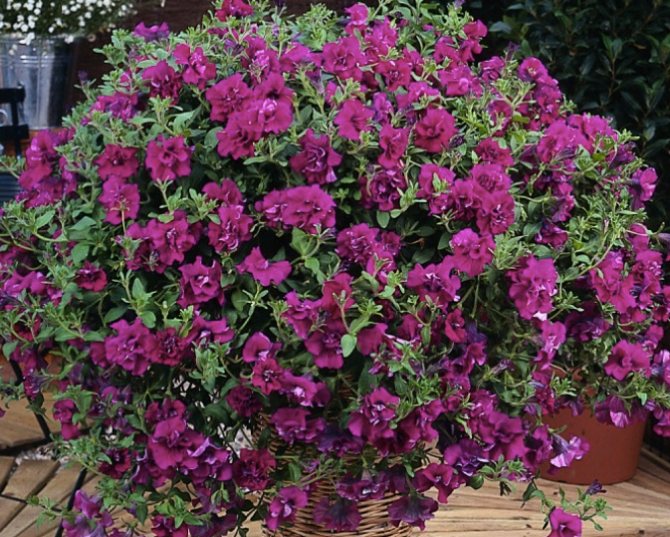

Beautiful in any weather
“What is snow for me, what is heat for me, what is pouring rain for me” - such words are quite suitable for describing surfinia. The flower photo shows gentle gramophones, but they are quite resistant to different weather changes.
The older relative of the plant, petunia, is not resistant to adverse weather changes. In strong winds, the petals of the petunia are torn, and they become pitiful. When it rains, the flowers turn into a homogeneous sticky mass.
Amateur flower growers are advised to hide pots, flowerpots and pots with annual plants under the roof during bad weather. This is very inconvenient and troublesome; flowers can be damaged while moving. Unlike petunias, surfinias will show their best in both rain and windy weather. They will remain neat and attractive. Sometimes you have to remove buds spoiled by water from the bush. But others will readily appear in their place.
The ideal ampelous flower is striking in its resistance to negative influences, the main thing is not to confuse it with other similar plants.
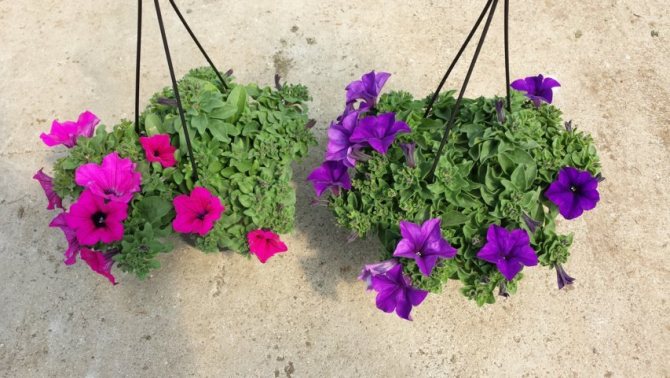

New surfiniya varieties with unique qualities
In the breeding of the company, new varieties of surfinia have appeared under the Specials series, which have special characteristics. Representatives:
- Surfinia® Amethyst - does not require formation, grows with a thick head, purple flowers with a white throat and a pleasant aroma;
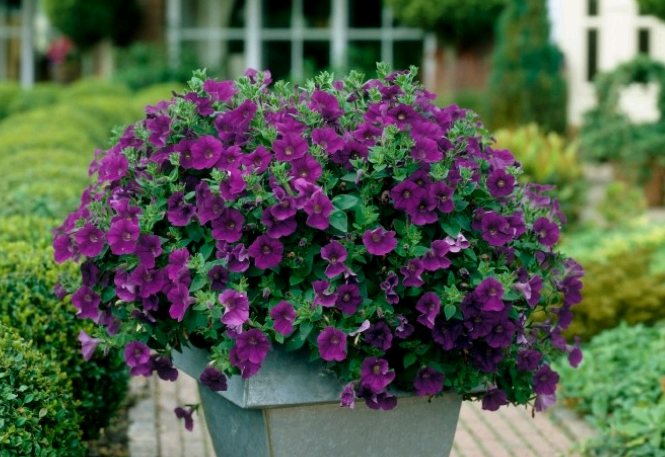

- Surfinia® Picotee blue - has a dense bush with long branches, graceful flowers of bright blue color with a white border. It is characterized by early and profuse flowering .;
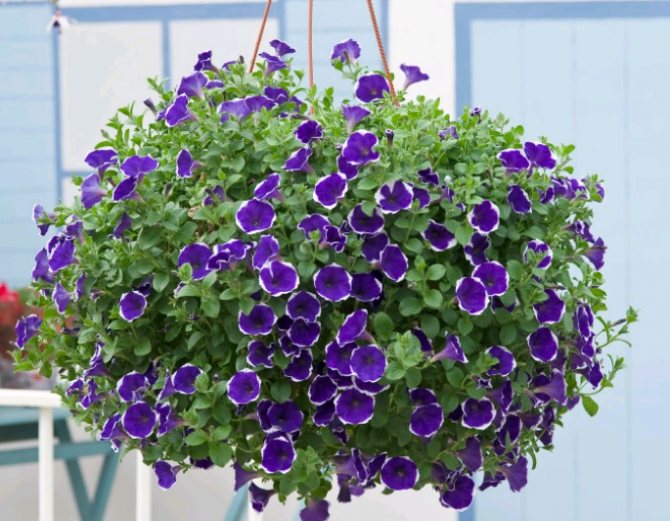

- Surfinia® Green edge pink - characterized by a new color combination - pink with pale green edges. The bush is compact with powerful branching of stems in the form of a dense head.
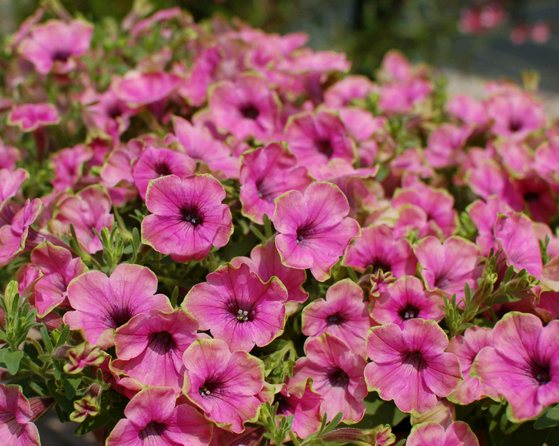

Where to buy Surfinia?
Most often, surfiniya is bought in garden stores or at flower exhibitions in the form of ready-made seedlings. The grown seedlings perfectly tolerate the transplant, take root well and quickly build up the green mass.
The seed method of reproduction of surfinia is practically not used, since the plant sets few seeds, and even they have low germination. When buying seeds, you should pay attention to their shelf life. At the same time, it is important to know that pelleted specimens have a shorter shelf life than conventional ones.
According to the reviews of florists grown surfinia, the plant easily takes root in a new place and requires a minimum of attention.
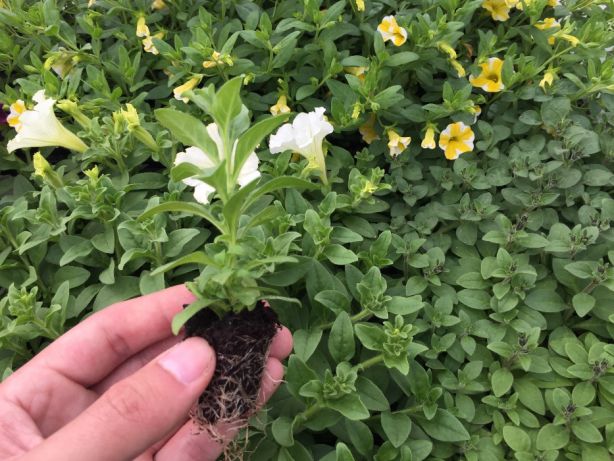

Growing conditions, care, reproduction
Surfinia is not a very moody flower, but more demanding than the common petunia. To grow a healthy and beautiful plant, it is necessary to create favorable conditions:
- Warm temperature conditions;
- Good illumination;
- Regular and abundant watering during the hot season;
- Neutral or slightly acidic soil pH of the sandy type;
- Top dressing with mineral fertilizers in the spring-autumn period;
- Protection from rain and wind.
Petunia Surfinia needs pruning of shoots. When the branches reach 20-30 cm, they should be pinched, which will help shape the bush and make it more lush. But it must be remembered that pinching is carried out precisely in the early stages of growth, since late pruning delays flowering by 2 weeks.
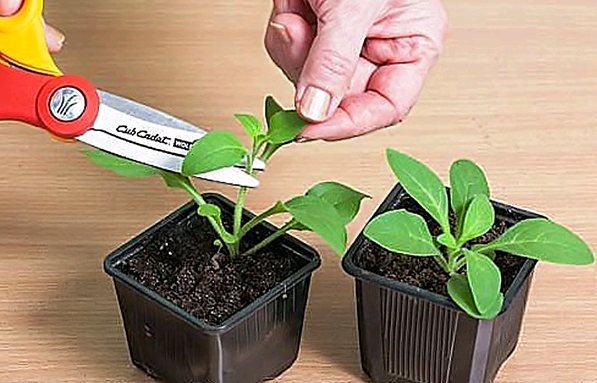

During the growing season, the rules for caring for surfinia almost do not differ from the rules for caring for an ordinary petunia. Its abundant flowering is ensured by the introduction of complex fertilizers and the regular removal of faded inflorescences and shoots that violate the shape of the bush.
Bush formation
Plants form their bushes without the help of a person, but if there is a desire to increase the surfinia cap, then the shoots 20-30 centimeters long should be pinched.
During the flowering period, the bushes are examined and the wilted buds are removed, so the flower will look more neat.
The specimens of plants that you like are saved for winter-spring cuttings. The flower takes root quickly, and beautiful plants will be ready to grow and bloom by the new season. The main thing is that they do not suffer from pests.
Reproduction
There are two ways of reproduction of Surfinia: seed and vegetative.
- The seed method is available for all types of petunias and only for some types of surfinia. Surfinia seeds have poor germination, and some of its varieties do not give them at all. For planting, it is recommended to purchase F1 hybrid seeds from specialized stores;
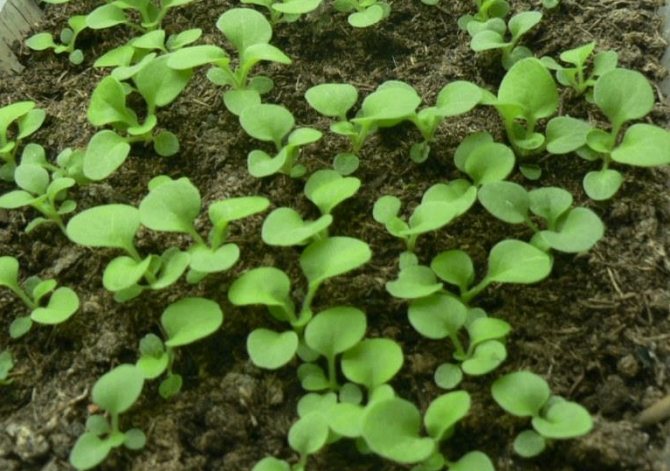

- For propagation in a vegetative way, cuttings are harvested. To do this, cut the cuttings about 5-7 cm long with a sharp knife, scissors or pruning shears, place them in containers with moist soil and trace elements, which are placed in a mini-greenhouse for a couple of weeks. After 14 days, the planting material will be ready for transplantation to a permanent place.
Landing features
Each plant requires a special approach to itself. There are secrets and rules for planting seedlings. Unfortunately, it happens that after the applied diligence the plant actively blooms and grows, then abruptly stops its growth and begins to wither. In order to avoid such an outcome, you should know some of the features of care.
All surfinia varieties have potential strength. For the growth of the bushes, you will need a large amount of soil and food. In the presence of these two components in abundance, the plant will gain its growing volume and power. A 30 liter pot can hold 4 plants.
Surfinia flower will feel great in well-loosened, fertile soil. When planting, it is better to use ready-made fertilizers, they nourish the plant longer.
The form of such fertilizers is in the form of granules or capsules. Under the influence of moisture, they will gradually dissolve and nourish the roots of the plant. Throughout the season, the soil will be enriched with minerals and trace elements necessary for the flower.
Fertilizers are not enough for a constant and dense flowering. In warmer climates, with a lack of moisture, hydrogels - water-retaining balls - should be added to the soil.
Surfinia wintering
In autumn, surfiniya bushes, intended for wintering, are heavily pruned. If petunia grows in a garden bed, you should dig up a plant with a large clod of earth, place it in a container and transfer it to a bright, well-ventilated room with a temperature of about + (10-12) oC.
The plant should be provided with moderate watering, not allowing the soil to dry out too much. In the spring, planting is corrected by removing weak, dried, diseased shoots. Prepared seedlings are placed in a permanent place in a previously prepared soil substrate.
Landing
Surfinia seedlings are most often grown by cuttings, and not from seeds. Of course, you can try to get a full-fledged healthy plant from seeds, but in most cases even carefully selected seeds rarely germinate in the required volume.
There are several simple rules for planting this unpretentious plant:
- initially, the future color scheme of the flower bed or flower arrangement in the basket is selected from the photo, since someone likes a monochromatic waterfall of buds more, and someone loves a colorful carpet;
- cuttings occur from August to September, so that by spring young plants can begin to form buds;
- for full development, plants need to provide at least 16 hours of daylight hours;
- for planting cuttings, plastic cups with a volume of 0.25 liters are well suited;
- for planting, an apical stalk is selected, whose length can reach ten centimeters, with the lower leaves removed. It is not worth pulling with the planting of the cut cut, after a couple of hours its vitality drops sharply;
- after dipping in Kornevin powder, the cutting is deepened by 2/3 of the length and the soil is thoroughly moistened throughout the entire growth period of the seedlings - this is the care;
- ready-made seedlings are transplanted into prepared containers or on a flower bed. To create the feeling of the solidity of the flower carpet, the plants are planted quite densely - about 70 plants per 1 m2.
The use of surfinia in the landscape
Petunia Surfinia is a popular plant in the landscape design of squares, parks, summer cottages.
Most often, surfiniya petunia is used to decorate balconies, terraces, verandas. For this, special baskets and balcony containers are used.
Important. When using dense planting of petunias in baskets, containers or pots, weak and rotten shoots should be constantly removed to ensure the splendor of the flowering.
Surfinia go well with any plants, emphasizing their uniqueness. With their help, it is possible to emphasize the features of the area and hide its flaws.
Surfinia (Surfinia) is a specially bred variety of ampelous petunia, its special successful hybrid, resistant to bad weather, not afraid of wind and rain. The Japanese have the rights to the SURFINIA trademark.
Surfinia is distinguished by powerful hanging stems, the length of which can reach up to 2 meters in favorable conditions and unusually abundant flowering throughout the season.
In European countries with warmer and milder climates, these beautiful flower plants are very large, strewn with flowers. In more severe conditions, with rains, cold nights, early frosts, surfinias are more modest, but with proper care they will turn your balcony or terrace into a garden of paradise.
Now in the world there are many varieties of sulfinia, which differ in the size and color of the flowers. Surfinium seeds give very little or not set them at all. The seeds do not retain their parental properties, although in recent years there have been publications about varieties yielding seeds with the properties of mother plants. To date, a lot of surfinias have been bred, they have been combined into a variety series, and there is debate that surfinia is already some kind of separate flower, and not petunia.
Care and maintenance of surfinia is about the same as that of petunia. Vegetative reproduction - cuttings are cut from the mother liquors stored for the winter in March and rooted under a film.
More often they buy ready-made surfiniya seedlings. It is difficult for an inexperienced buyer to figure out where is petunia and where is surfinia. Following is noteworthy.
Most surfinia have many lateral branches, which are horizontal in small plants, and as they grow, they go down. Shoots of young petunias generally grow upward at a 45-degree angle.
The price of ampelous surfinia is usually higher, so if they offer cheap seedlings called surfiniya, think carefully.
To get a beautiful large surfiniya bush, professionals advise you to do the following: remove all flower buds that appear on the bush until a completely beautiful head or cascade of your ampel petunia grows and forms, and only then allow it to bloom.
Surfinia are most often grown in hanging baskets or balcony boxes. Surfinia bushes can be used to decorate balconies, terraces, verandas and slopes in gardens. The soil should be nutritious, as for petunias, consisting of humus, peat, turf or leafy soil and sand. The substrate should have an acidity of pH -5.5-6.5.
Seedlings are planted in pots and containers of a rather large size, since surfiniya bushes usually grow strongly. They are fed often, at least once a week.
You will not regret if you decorate your house or personal plot with ampel surfacing. With just a little effort, you will end up with incredibly beautiful plants that will bring you a lot of joy.
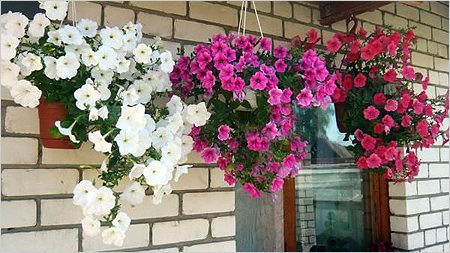

Top dressing
In the photo, surfiniya is striking in its splendor of flowering. But not everything is so simple. This flower is quite gluttonous.The root system is not always capable of feeding a huge crown with numerous flowers. Regular feeding will come to the rescue.
The best are liquid, they are made from mineral or organic fertilizers. Once a week, they are added to the soil to the flower, before diluting with water.
Immediately after planting the seedlings, fertilizers with a high nitrogen content are used. It promotes active growth of shoots. Phosphorus is also needed to strengthen the root system.
When buds appear and until the end of the flowering period, fertilizers based on potassium and phosphorus are added.
Flowers planted on fertile soils do not need frequent feeding, it is enough to support the plant 3-4 times per season.
What ensures the beauty of the petunia variety
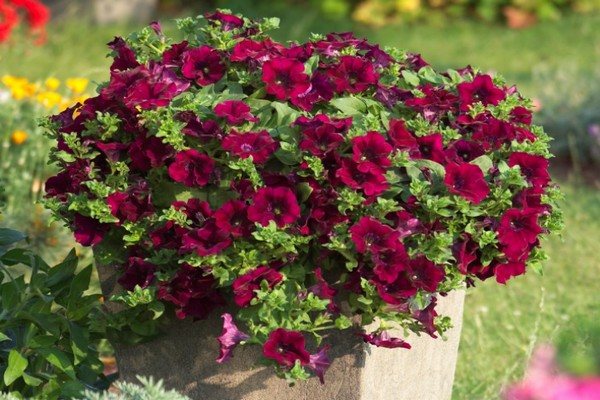

Petunia Surfinia: photo
The flower family has an indescribable beauty. Different varieties have their own refinements.
The variety is not considered simple. The petals of Surfinia petunia have a diameter of about 9 cm, the color is bright and saturated, in the middle it has a beautiful darkening. There may be a white border around the edges or, for example, a flower may have beautifully designed veins. This is more common in primary and standard varietal varieties.
Petunia flowers Surfinia Double have thick and double petals, interesting and unusual colors. Varieties of Surfinia Mini are distinguished by small waterfalls of flowers with a diameter of no more than 6 cm, but the shades, nevertheless, remain saturated.
Surfinium primer
Loam with an acidity of 5-6 pH is considered an ideal soil option for growing crops, it also grows well in sandy soil. The plant can easily adapt to any land, as long as it is fertile, light and loose.
When growing surfinia in flowerpots or containers, you can use a mixture of garden soil and humus. To make the substrate loose, add one part of sand, two parts of humus and three parts of the main soil to it. Before planting surfinia, 5 centimeters of fine expanded clay should be put on the bottom of the container as drainage. A flower grower should not forget about him when planting a flower in open ground.
In order for the soil in the pot to retain moisture well, hydrogel or perlite should be added to it, and if the plant is planted in a garden bed, it must be mulched with a thick layer of sawdust or compost.
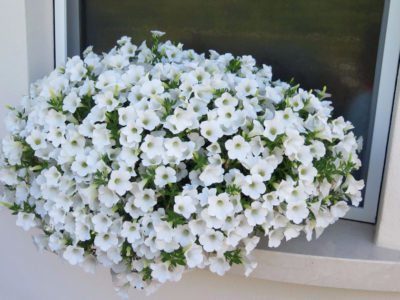

Video
We offer useful information about the main differences between petunias and surfinias, as well as about the features of reproduction and care of these plants in the following videos:
By the main specialty - an accountant, therefore, even at a summer cottage, he strives for accuracy and the achievement of perfect order in everything. Gives preference to the cultivation of grapes. I am sure that the deeper you delve into truck farming and gardening, the more you understand that there is no limit to perfection!
Found a bug? Select the text with the mouse and click:
Both humus and compost are rightfully the basis of organic farming. Their presence in the soil significantly increases the yield and improves the taste of vegetables and fruits. They are very similar in properties and appearance, but they should not be confused. Humus - rotted manure or bird droppings. Compost - rotted organic residues of various origins (spoiled food from the kitchen, tops, weeds, thin twigs). Humus is considered a better fertilizer, compost is more readily available.
Tomatoes have no natural protection against late blight. If late blight attacks, any tomatoes (and potatoes too) die, no matter what is said in the description of varieties ("varieties resistant to late blight" is just a marketing ploy).
From varietal tomatoes you can get "your" seeds for sowing next year (if you really like the variety). And it is useless to do it with hybrid ones: the seeds will work out, but they will carry the hereditary material not of the plant from which they were taken, but of its numerous “ancestors”.
"Frost-resistant" varieties of garden strawberries (more often simply - "strawberries") also need shelter, as well as ordinary varieties (especially in those regions where there are snowless winters or frosts alternating with thaws). All strawberries have shallow roots. This means that without shelter, they freeze out. Assurances of sellers that strawberries are "frost-hardy", "winter-hardy", "endure frosts down to -35 ℃", etc., is a deception. Gardeners should remember that the root system of strawberries has never been changed.
It is necessary to collect medicinal flowers and inflorescences at the very beginning of the flowering period, when the content of nutrients in them is as high as possible. Flowers are supposed to be picked with hands, breaking off rough pedicels. The collected flowers and herbs are dried, scattered in a thin layer, in a cool room at a natural temperature without access to direct sunlight.
In Australia, scientists have begun experiments to clone several grape varieties from colder regions. Climate warming, which is predicted for the next 50 years, will lead to their disappearance. Australian varieties have excellent characteristics for winemaking and are not susceptible to diseases common in Europe and America.
The homeland of pepper is America, but the main breeding work on the development of sweet varieties was carried out, in particular, by Ferenc Horvat (Hungary) in the 20s. XX century in Europe, mainly in the Balkans. Pepper came to Russia from Bulgaria, therefore it got its usual name - "Bulgarian".
Oklahoma farmer Carl Burns has developed an unusual variety of colorful corn called Rainbow Corn. The grains on each ear are of different colors and shades: brown, pink, purple, blue, green, etc. This result was achieved through many years of selection of the most colored common varieties and their crossing.
Natural toxins are found in many plants; those that are grown in gardens and orchards are no exception. So, in the seeds of apples, apricots, peaches there is hydrocyanic (hydrocyanic) acid, and in the tops and peels of unripe nightshades (potatoes, eggplants, tomatoes) - solanine. But do not be afraid: their number is too small.
Beautiful creation
All types of surfinia bloom excellently, the flowers themselves are refined, graceful with delicate shades, and there are catchy and defiant colors. Definitely, such a plant will not leave indifferent experienced gardeners.
The flower bud resembles a gramophone, up to 10 cm in diameter. Delicate petals have a clean and bright color, which darkens noticeably towards the center of the throat. The very first varieties of flowers have streaks of a contrasting shade or a light border along the edges of the gramophone.
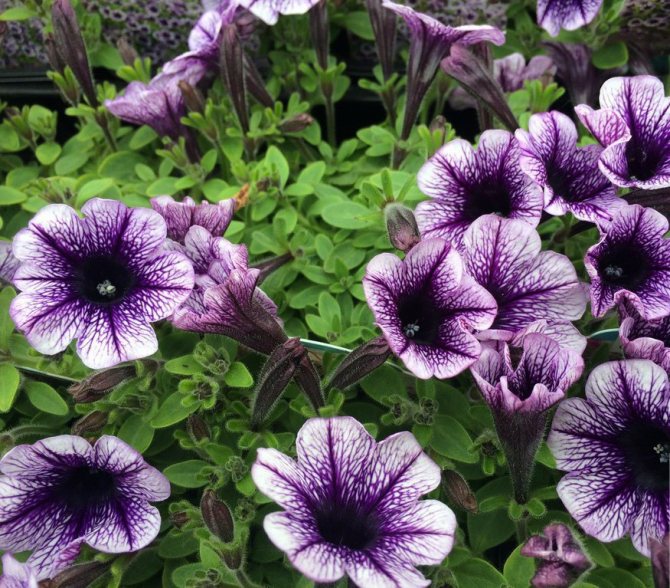

Hanging shoots of impressive length, drenched in delicate flowers, are mesmerizing. The color of surfinia flowers can be different and even unexpected:
- white;
- pink;
- peach;
- yellow;
- blue;
- terracotta;
- pink with a green border around the edge of the gramophone;
- red;
- purple.
Surfinia Double is considered to be the most beautiful. It pleases the eye with an abundance of double flowers of impressive dimensions and different shades. The variety Mini evokes sympathy. Small gramophones are very expressive and attractive, their diameter is no more than 5 centimeters.
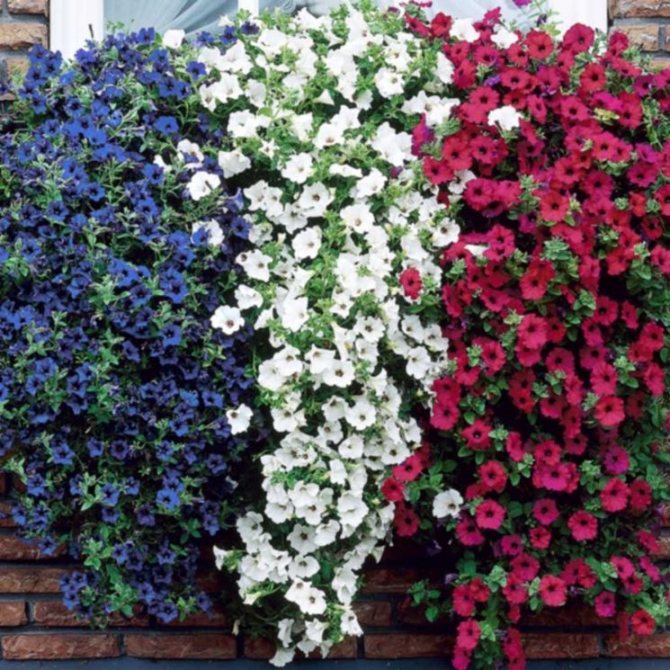

How did the variety of petunia Surfinia come about?
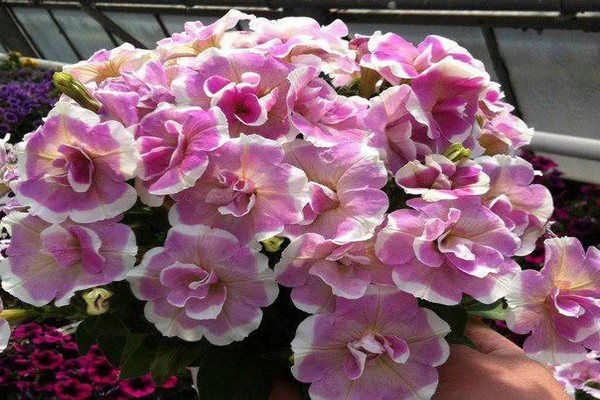

Petunia Surfinia: photo
Breeders from Japan have created an unusual variety of Surfinia, or as it is also called Sulfinia. Suntory decided in the 70s of the 20th century to hybridize the plant cells and adapt the large-flowered plant to poor climatic conditions. As a result, scientists created an ampelous petunia, reproduction of this variety can be carried out only by cuttings in order to preserve varietal characteristics. You couldn't get seeds from the plant. Petunia received the trade name Surfinia and received wide popularity and positive reviews among gardeners.
Species diversity
Surfinia ampelous flower has more than twenty species, which differ from each other in the color range of buds, the length of the shoots. The most popular varieties are presented in our selection:
- Surfinia Velvet (Surfinia Velvet) - a series of flowers characterized by increased resistance to pests and diseases. Possessing good seed germination rates.
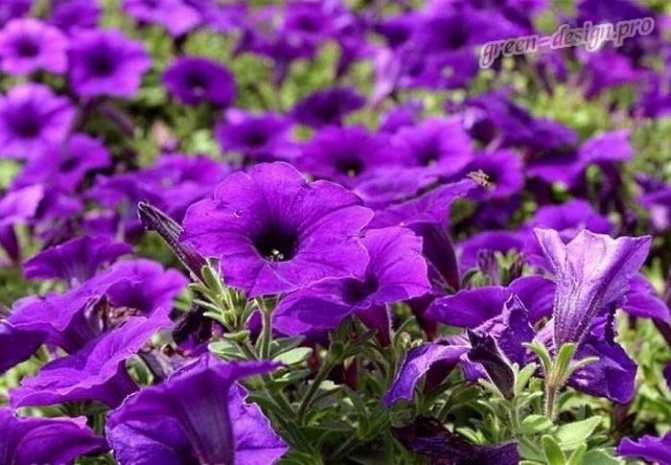

Surfinia Velvet
The shoots of the flower reach a meter in length. Abundant flowering, long lasting. Suitable both for growing in containers and for decorating flower beds. In the open field, over time, it takes on the appearance of a green carpet, abundantly decorated with buds. - Calibrachoa surfinia (Calibrachoa surfinia) - it is distinguished by an abundance of flowering, rather small flowers.
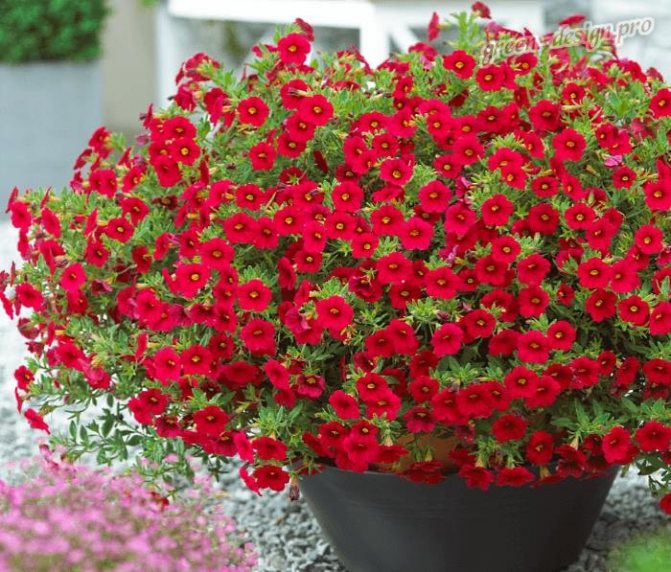

Calibrachoa surfinia
The diameter of the opened "gramophone" is about three centimeters. The coloring is varied. There are also terry varieties that are distinguished by a special velvety buds. - Burgundy (Burgundy) - it has a rich wine shade of a bud, a branchy structure of a bush.
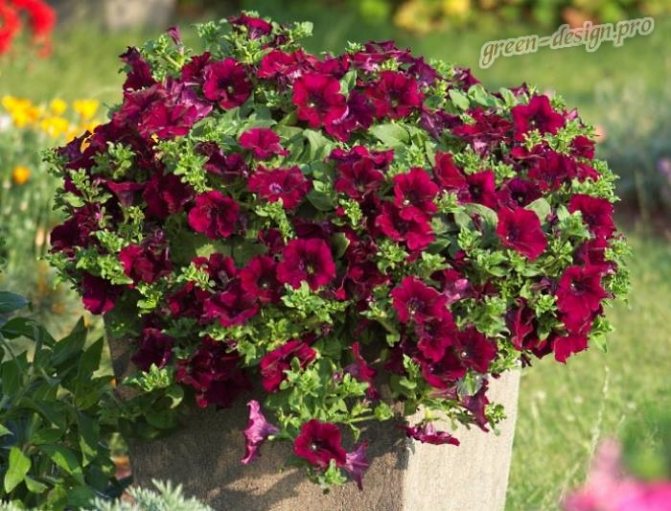

Surfiniya Burgundy - Surfinia Yellow Dream (Yellow Dream) - has a pale yellow color of buds, abundant flowering.
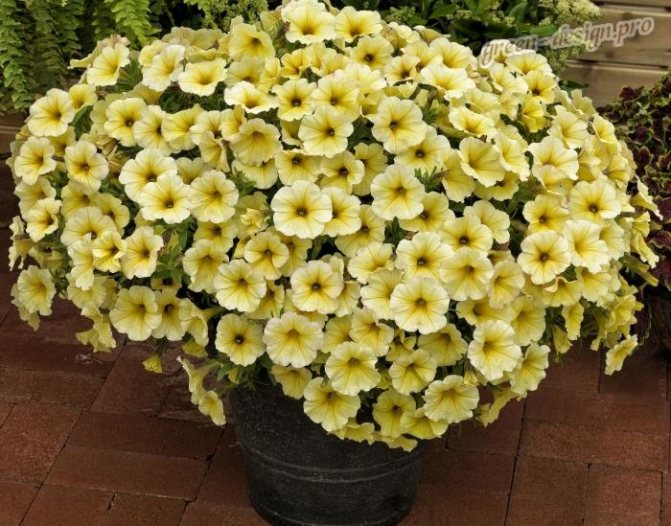

Surfinia Yellow Dream
Its flowers combine several shades of yellow, beautifully shimmering from a more intense to pale color. It blooms almost to frost.
Sowing surfinia seeds
Most often, surfinia is grown at home from seeds. For these purposes, it is necessary to choose a high-quality seed, paying particular attention to the shelf life and the integrity of the package.
Surfinia is sown in early spring in the following sequence:
- Preparing the container - any container or small pots will do.
- Preparation of the substrate - peat tablets, or sand with peat. The seedling soil must be breathable.
- Arrangement of a drainage system from foam balls, pebbles or expanded clay.
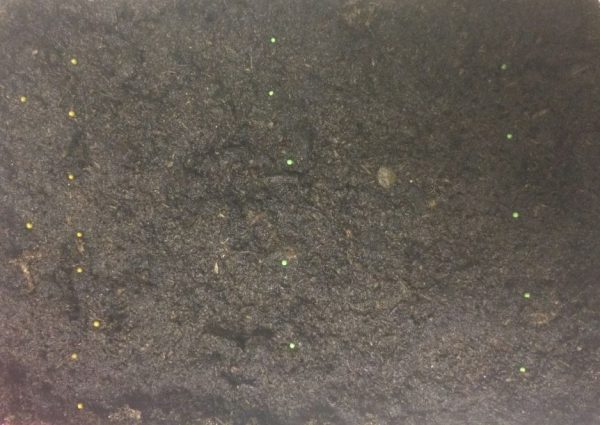

Surfinia growing from seeds
- Due to its small size, the planting material should not be deepened into the ground. Seeds in several pieces are spread on moistened soil and covered with a film.
- The pots are opened daily for ventilation.
- Watering is carried out from a spray bottle as the soil dries out (it should remain slightly moistened).
- The pots should be installed in a confined place, where the air temperature reaches at least 20 degrees.
- The first shoots should appear in 15-20 days. At this time, the roots must be sprinkled with fried sand to protect them from decay and strengthen, and eliminate the protective film.
- Transplanting one copy into pots is done when the plant has 2 leaves.
Brief tips for growing and care
According to the opinions of experienced florists, the cultivation of petunias and surfinias requires standard agricultural techniques. When planting in pots or other containers, a soil consisting of humus, peat and river sand in a ratio of 2: 2: 1 is ideal for plants.
In order to get a lush flowering bush from a petunia, you need to periodically pinch lashes to stimulate branching. In surfinia, it is enough to simply direct the stems in the right direction, since most often it independently quickly braids all the space allotted for it. If desired, you can pinch the apical parts of the shoots, however, after such a procedure, the plant sometimes stops flowering (for about a month), but then blooms with renewed vigor. To maintain decorativeness, you should promptly remove dried leaves and flowers, both in petunia and surfinia.
Read also TechnoNicol ridge aerator dimensions
In care, the most important are timely, sufficient watering - daily, and in the heat - twice a day (morning and evening) and regular feeding with complex fertilizers.According to gardeners' reviews, surfinias are less (compared to traditional petunias) susceptible to common diseases and pests of crops, which you can learn in detail about in the article on our website.
Features of plants
All modern cultivated varieties of petunia are obtained as a result of hybridization of wild species originating from South America, and differ in a variety of colors and shapes.
Petunia
Petunia belongs to the nightshade family, belongs to the genus of perennial herbaceous plants, but is grown primarily as an annual. Hybrid varieties are famous for their high level of decorativeness, and the intensity and duration of their flowering largely depend on soil and climatic factors and competent care. Plants are propagated generatively (by seeds) or vegetatively (by cuttings).
Depending on the type of shoots, the shape and size of the bushes, varieties are divided into two types:
- bushy (or bush, upright) - with straight shoots from 15-20 cm long (undersized) to 80 cm, developing in the form of dense compact bushes-pillows;
- hanging (or creeping, ampelous) - with long shoots covering a large area. With horizontal gardening, they are used as ground covers, and with vertical gardening in hanging containers (pots), they fall in a cascade. The differences between cascading petunias and ampelous ones are conditional, therefore they are often considered as a single species, highlighting cascading (or semi-ampelous) petunias in a separate category or group.
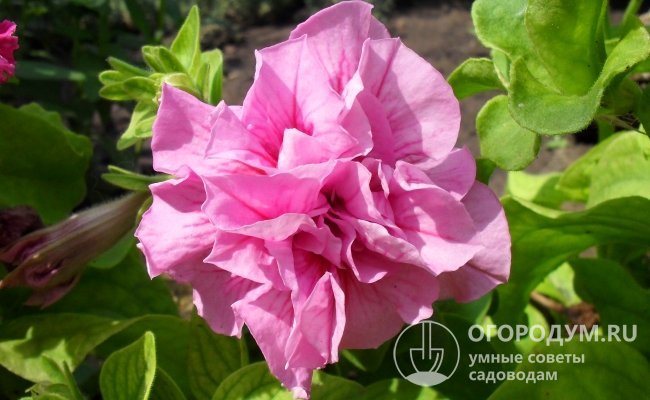

Among the bush varieties, varieties with luxurious double flowers have gained particular popularity.
Ampel petunias are distinguished by several parameters that characterize the shape, color and size of flowers. According to the commercial classification, categories or variety groups with improved decorative characteristics are distinguished among them, for example, surfinia, supertunia, fortunia and others.
Surfinia
Surfinia, registered as a trademark, belongs to the collection of F1 Surfinia hybrids, bred by Japanese breeders. This varietal group of ampel petunias is different beautiful branchingsince shoots develop from all internodes and high growth rate... Creeping on the ground or hanging (drooping) powerful lashes can reach a length of about 2 meters.
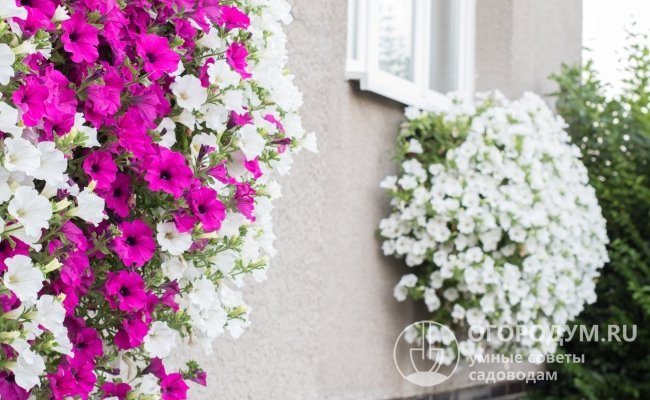

Surfinia quickly grows in the form of a cascade, a pillow and even a ball - it all depends on the method of planting and forming the plant, it blooms actively throughout the season
These hybrids also have increased endurance and resistance to adverse weather factors, providing early, long and abundant flowering (from May to autumn cold weather). The flowers, located along the entire length of the shoots, are of medium (5-6 cm in diameter) or large (8-10 cm in diameter) sizes. Their shape is mostly classical in the form of "bells" or "gramophones" with a smooth surface and edges. Flowers can be double or velvety, predominantly white, blue and pink in color. The seeds in them ripen in very small quantities or are not tied at all, therefore the main breeding method is vegetativeusing cuttings.
The surfinia root system is very powerful. For its full development, when grown in individual containers of the substrate, a volume of at least 8 liters is required per plant.
Surfinia has many varieties, which, according to the reviews of amateur flower growers, almost all are successfully grown in garden plots. The most popular were following varieties:
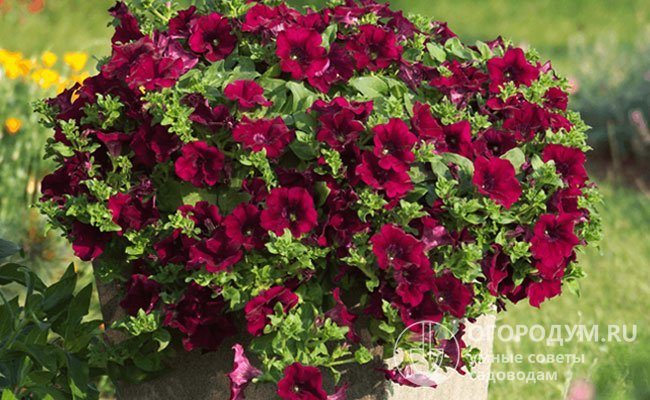

Burgundy (Surfinia Burgundy) - compact, but at the same time massive and densely branching bush with abundant flowering, large flowers (8 cm in diameter) rich wine color
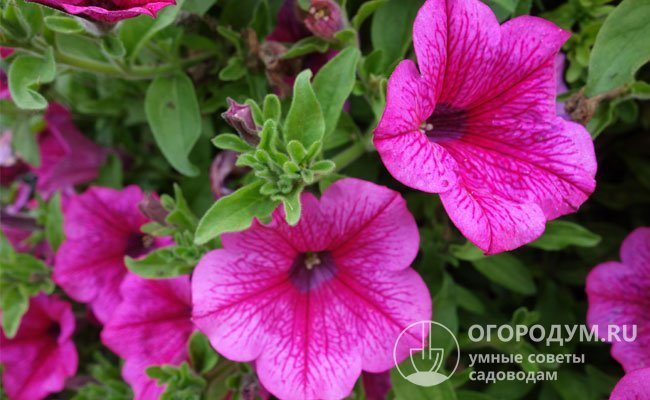

Hot Pink (Surfinia Hot Pink) - has large flowers of bright pink color with pronounced crimson veins running from the throat to the wavy edge of the flower
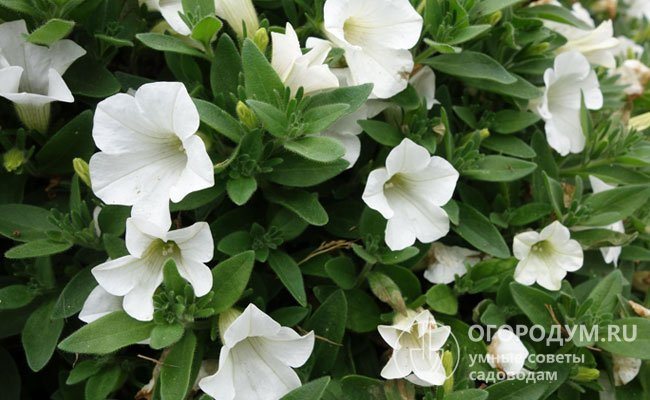

Table White (Surfinia Table White) - has snow-white bell-shaped flowers that densely cover the entire bush. The flowering period lasts from May to the coldest months
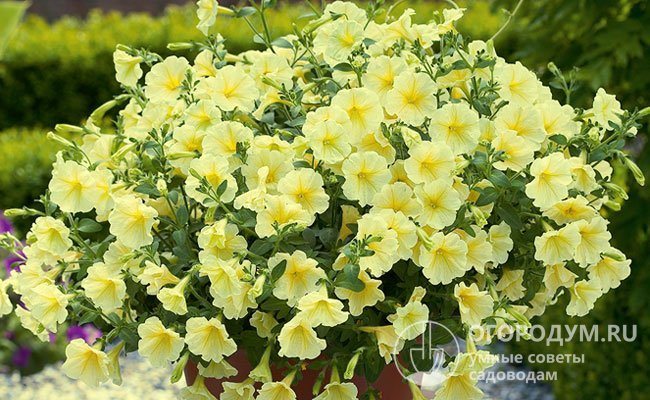

Ylow (Surfinia Yellow) - one of the first ampelous petunia hybrids. This variety has flowers of a pale yellow color, early and abundant flowering
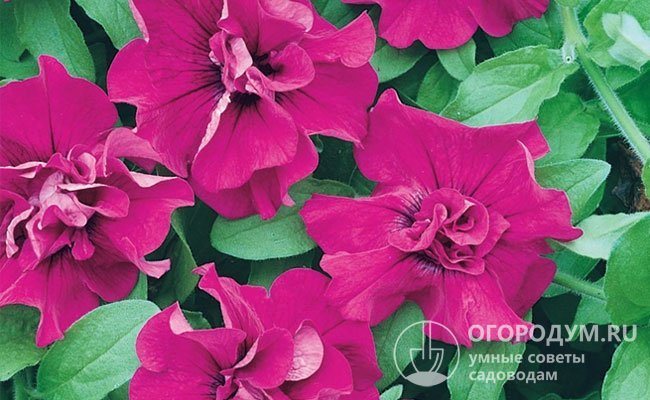

Double Purple (Surfinia Double Purple) - double petunia with bright purple flowers. The variety is characterized by strong growth and resistance to excess moisture in summer.
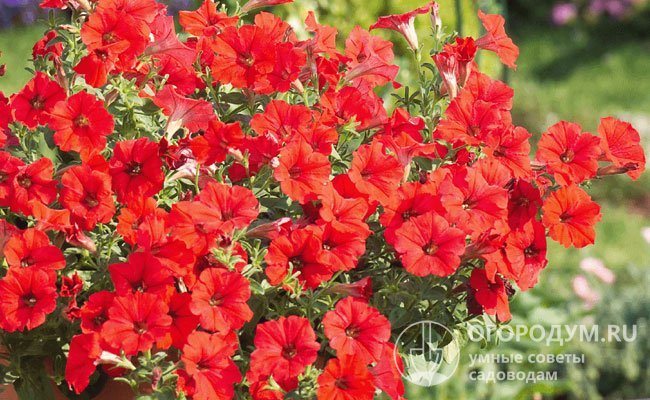

Ed (Surfinia Red) is a very beautiful variety that has won many awards at various exhibitions. Its flowers are painted in a rich, perfectly pure scarlet color.
Features of the reproduction of surfinia
Surfinia reproduces both vegetatively (cuttings) and generative methods.
- Most often in culture, surfinia is bred by cuttings. In this case, all the characteristics of the mother plant are fully preserved. Cuttings are obtained from cut shoots with 2-3 pairs of leaves. The features of planting and caring for cuttings are discussed above, in the section "Cultivation of surfinia by cuttings."
- Seed propagation is also possible, although it is considered less popular due to the low germination of seeds. For planting surfinia, it is better to buy seeds in specialized flower shops, since seed material collected by yourself has a very low germination rate. The peculiarities of planting and caring for seeds are discussed above, in the section "Cultivation of surfinia by seeds".
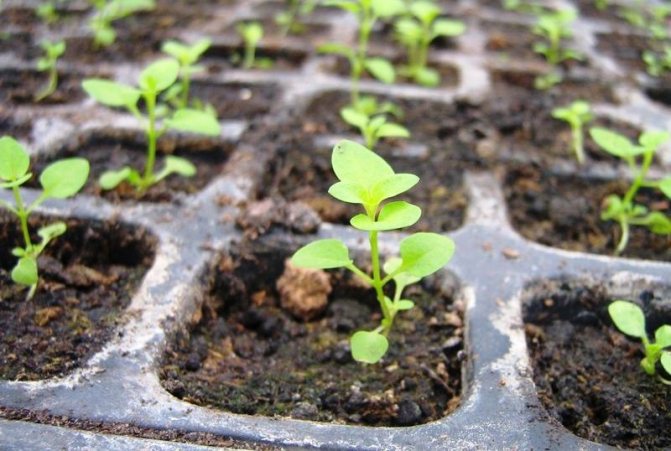

Breeding new varieties
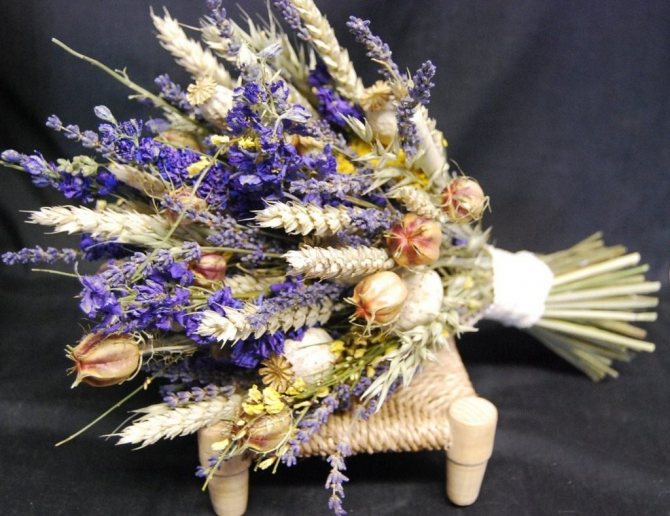

Since the time when gardeners looked closely at the flower, they began to vigorously grow it. They bred a lot of varieties, as beautiful as the parent plant. It is distinguished by monochromatic lilac flowers with a dark center. This darkening of the "neck" is the hallmark of calibrachoa. Today, varieties of various tones and nuances have been bred, but their center of the flower is darker than the petals. The buds are simple and beautiful for that. They look like petunia flowers.
Description of calibrachoa
Calibrachoa is a perennial of the nightshade family; in its natural environment, it is distributed in Argentina, Brazil and Uruguay. Gardeners grow hybrids of natural varieties, they are annuals. The plant has long drooping stems, because of which the flower is considered ampelous. In length, the processes reach from half a meter to one and a half meters. The stems of the plant branch out and lignify over time. The leaves are small lanceolate, one centimeter wide, three centimeters long. Stems and leaves are pubescent.
Calibrachoa has flowers like “gramophone”, three centimeters in size. The buds in the natural environment are purple. Hybrids with corollas of white, pink, yellow, scarlet, raspberry, sapphire, coffee color were bred. The veins along the petals are colored in a brighter tone.
Plant varieties
In nature, there is only one tone - lilac. However, breeders managed to develop varieties with raspberry, yellow, pink, sapphire and cherry colors. Gardeners distinguish the following varieties:
- a million bells;
- kablum blue;
- superbells;
- cabaret;
- noah;
- terry;
- sunset;
- kablum yellow;
- bels;
- tequila Sunrise hybrid.
A million bells. The most popular ampelous variety, reaching up to one meter in height. With bright colors: sapphire, lilac and violet. Propagated by seeds, however, 21 days after planting, watering with a growth stimulator is needed. The variety lives up to the name - it stands out for its intense flowering.
Kablum blue, can also be called kablum deep blue hummingbird. The species is popular, as are the million bells. In our region, the variety began to grow one of the first. Propagated by cuttings, looks remarkable in flower beds and flowerpots.
Terry calibrohoa, or mini compact pink double. The variety of the "Double" and "Compact Double" series has several types of different colors: bright yellow (double yellow), pink (double pink), red (double ruby), sapphire (double blue). A typical feature of the variety is the structure of the flower: corollas are full, multi-layered.There is only one minus of terry varieties - a small number of flowers, which is made up for by the beauty of the buds.
Cabaret. The variety contains twelve subspecies. Among them, only plants with white colors, but there are also variations. A flowerpot with a similar flower looks like a ball with a large number of white bells.
Noah. Contains six color options. Among them there are white and lilac varieties. Compositions from plants of the species look romantic and sophisticated. The buds are painted in a couple of tones. The color of the center of the bud and lobe stripes on the petals differs from the tone of the flower. The branches are up to half a meter long. The plant needs care. Grows well in shaded areas and tolerates little moisture. If you save it for the winter as a perennial, then next year the plant will bloom little. Mostly planted as an annual flower.
Bells. The series includes eight plant varieties. Flowers 3.5 cm in size from yellow to burgundy. If you do not cut the branches, then they are stretched up to a meter in length. The plant has few leaves. Bells varieties bloom in May. Lush scattering of bells is not afraid of hail and rain. Withstands fluctuations in the weather. In composition with white petunias, this look makes an alluring duet.
Tequila Sunrise hybrid. Has a catchy color, a plant is grown from grains. Branching processes create a sphere with a volume of 36-40 cm, covered with bells. Blooms constantly with renewing buds. Used in hanging baskets, balcony boxes.
General information
The colors of the flowers are quite varied, as well as their shape. The inflorescences are large in size. The flowering time of surfinia lasts almost throughout the summer.
In botany, only 25 varieties of culture are known, which have different shapes and colors of inflorescences. All varieties were obtained by crossing various types of petunias.
Even a novice gardener can grow this unusual flower, the main thing is to create the necessary conditions, and then it will delight its owner with bright flowers for many years.
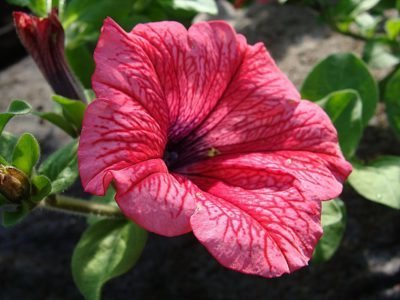

Plant development stages
Despite the beauty of the variety, you can see that the Surfinia petunia variety is a very strong and viable plant. If the flowers are in warm and fairly humid climatic conditions and feed well and constantly, then in 60 days the plant can form long branches (up to 2 meters). On the side, shoots form between the nodes, increasing their mass and forming into balls, pillows or waterfalls. The shape of the shrub depends on the planting technique that has been applied.
Important: A strong root system is capable of supporting the plant in growth and flowering. In order for petunia to receive sufficient nutrition, you need to use no more than 6 liters of soil per plant. If the containers are small, then it is best to plant small-sized ampelous petunias.
Growing at home
Wanting to see surfiniya on his site, the gardener must carry out the cultivation of the plant in accordance with all the rules.
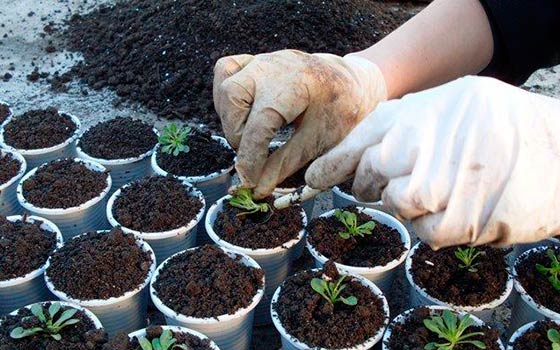

Not so long ago, it was not possible to purchase the seeds of this plant. All due to the fact that the producers who were engaged in selection were hiding the secret of the technology. So the cultivation of surfinia petunia was only available in a vegetative way.
At the moment, the seeds are available commercially. Perhaps the company decided to take such a step due to the fact that they began to call the ampelous petunia surfinia. A similar trend has begun to confuse even experienced gardeners.
It is worth noting the fact that petunia-surfinia is a hybrid petunia litter, but not a separate type of flowering plant.
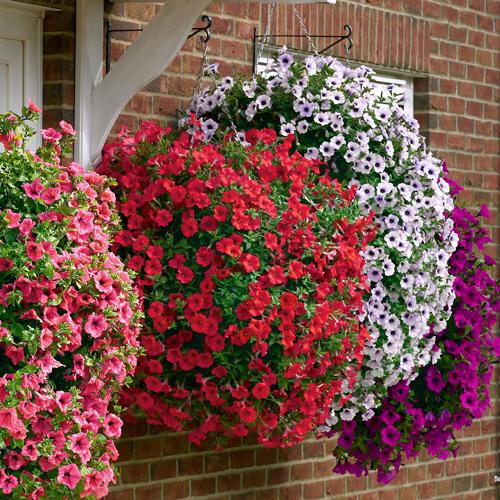

Ampel petunia Surfinia: Formation of a bush
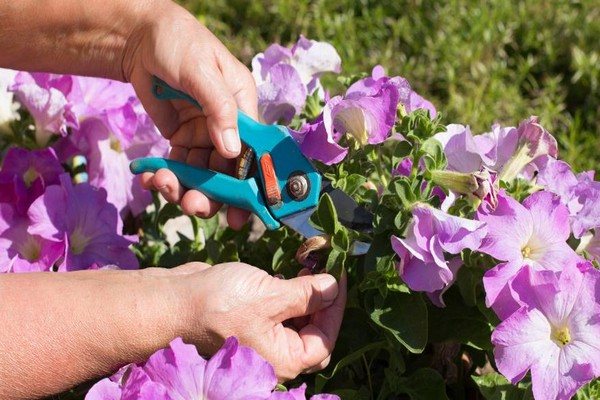

Varieties of petunia Surfinia rarely need shaping. But with poor branching of the bush, you need to pinch 20-30 centimeter shoots, after that the bush will be more fluffy.
When blooming, wilted flowers are removed. This ennobles the appearance of the plant and the petunia does not give extra energy to the formation of seeds.
If there are good plants, then it can be applied to cuttings of Surfinia petunia in winter or spring. Petunia takes root well, next season you can get a beautiful and wonderful plant.
Surfinia cuttings
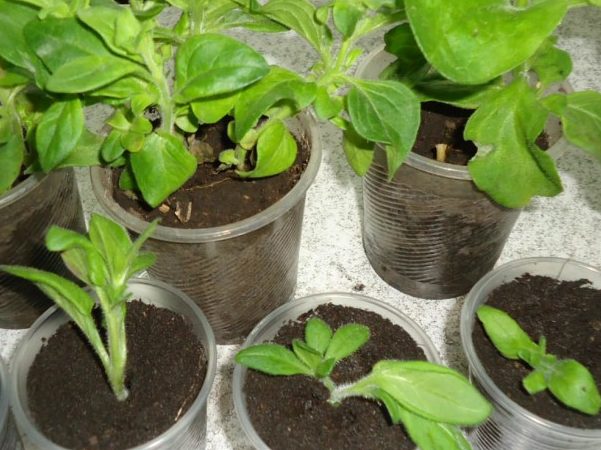

Propagation of surfinia by cuttings
Petunia surfiniya can also propagate by cuttings. This requires:
- At the beginning of autumn, you need to cut off a large specimen of the plant.
- Plant it in a fertile substrate.
- Cover with a jar or plastic wrap to create the desired level of moisture and warmth.
- When the soil dries up, it must be moistened, but moisture retention must be avoided.
- The greenhouse should stand until new leaves are formed on the plant.
- A viable bush can be observed already in the middle of spring, at which time it is transplanted to the place where it will grow on an ongoing basis.
Surfinia pot
In order for the culture to grow and develop normally, it is necessary to choose a spacious pot for it.
When planting a plant in a container, it should be borne in mind that at least five liters of volume should fall on one surfinium. In a pot with a capacity of thirty liters, you need to plant no more than three plants.
It is also very important that the tank has bottom and side drainage holes to improve the air permeability of the soil. If not, you can make the holes yourself.
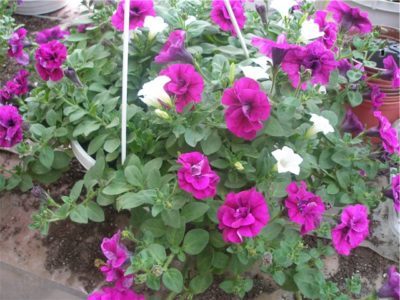

Content
- General information
- Surfinia varieties photo and names
- Surfinia cultivation and care in the open field
- Watering surfiniya
- Surfinium primer
- Surfinia pot
- Surfinia transplant
- Top dressing surfiniya
- Surfinia bloom
- Surfinia pruning
- Surfinia in winter
- Propagation of surfinia by cuttings
- Diseases and pests
- Problems when growing surfinia
- What is the difference between surfiniia and petunia?
- Conclusion
Landing Surfinia
Surfinia is usually grown from cuttings of mature plants. The seed method is theoretically also possible, but given the laboriousness of the process and the low germination of seeds, it is rarely used by flower growers.
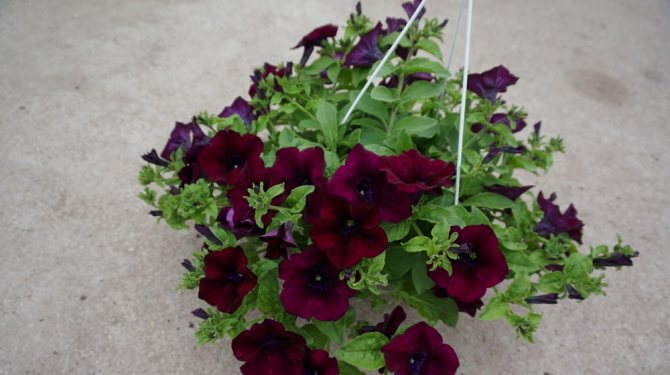

Conditions for landing Surfinia
- Surfinia is a light and heat-loving culture, therefore, it must be planted in a place where there will be enough sunlight. Hanging baskets or pots should also be placed with this particular feature of the plant in mind. To prevent long shoots from getting tangled and look as decorative as possible, flower pots should be hung from the leeward side. Optimally favorable place is the sunny side (with light partial shade at noon), without drafts and thick shade. With a lack of lighting, Surfinia begins to grow worse and stops blooming. To prevent rain from falling on the flower, the pots are placed under artificial canopies.
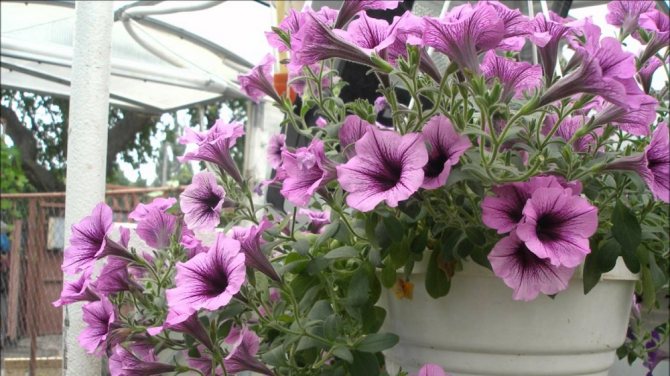

- The best soil for surfinia is considered to be loose, fertile loams or sandy loams with a neutral or slightly acidic reaction of the environment. Be sure to add lime (300 g per 1 m2) or charcoal to acidic soils. In the case of poor soil composition, it is better to fertilize it with organic matter before planting: humus or compost. The only exception is that you should not add fresh, not rotted manure, as it contributes to the development of fungal diseases and aggressively affects the plant. You can buy the necessary soil substrate or prepare it yourself. To obtain the desired soil mixture, peat and vermicompost are mixed in equal proportions, after which sod soil (twice as much as the prepared mixture) and a little vermiculite (for looseness) are added to this nutritious loose mixture.
- So that the roots of surfinia do not rot, the soil must be not only loose and light, but also permeable so that moisture does not linger in the soil. To do this, before planting, a drainage layer of fine gravel or expanded clay is laid at the bottom of a trench or flower pot. The thickness of the drainage layer should be at least 5 cm. In the case of using a flower pot, a spacious container should be selected so that the roots develop and grow freely.
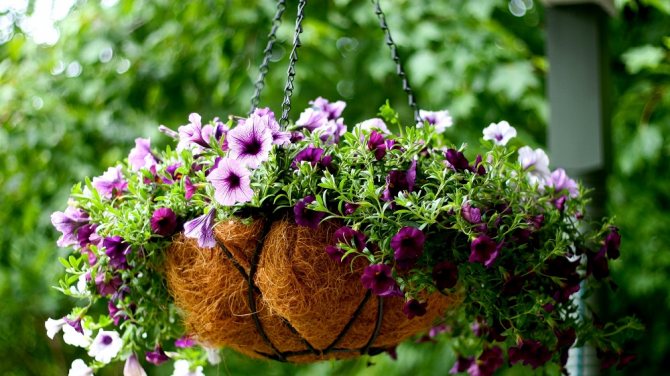

Florist reviews
Alena, 29 years old, Vologda
Last year I purchased Hot Pink surfinia - it looks very unusual due to large bright pink flowers with crimson veins. I planted it in flowerpots on the terrace. The most important thing is to provide a sufficient volume of soil (8-10 liters per seedling) and food. I paid special attention to the arrangement of drainage, since the stagnation of water in the flowerpot has a detrimental effect on the root system. I use expanded clay or large pebbles, I fall asleep about a quarter of the entire volume of the pot. I try not to allow the upper layers of the substrate to dry out, as drought leads to the rapid withering of the entire bush. I water it in the heat three times a day, fertilize it about once a month with Agricola, and remove the flowers as they wither. I don’t pinch fast-growing shoots, I only do pruning for a beautiful shape. I liked the variety very much - bright, glowing, just neon!
Tatiana, 38 years old, Kanev
I have been growing flowers for several years now. Recently I bought cuttings of the coveted surfinia in an online store, but after a while I realized that I had become a victim of deceivers who sold me simple petunias, which were not cheap at the same time. I want to share my experience: in order not to be mistaken, one must pay attention to the difference in the branching of these plants. Surfinia seedlings are larger, it gives a large number of side shoots, which at first spread horizontally, and as they grow, they fall down.
Raisa, 54 years old, Evpatoria
This season sprouted seeds of Marco Polo petunia (blue, large-flowered, cascading) and Aelita velvet velvet surfinia. Although the planting material of Russian producers rarely pleases me with the germination of seeds, their quantity and price, but this time I was very pleased. Both varieties turned out to be unusually beautiful, bloomed profusely, despite our heat, even if they could not be watered daily and fed regularly. My favorite terry varieties are much more capricious compared to them, so now I will only plant ampelous.
Resistance to negative climatic conditions
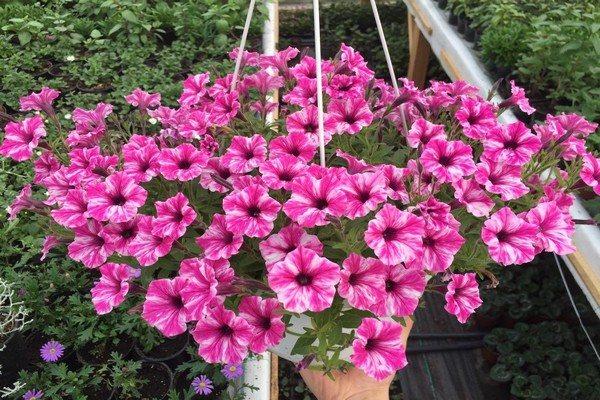

Most petunia varieties struggle with bad weather conditions. In windy weather, the petals of the plant almost open from the stem, and in rainy weather, the shape of the petunia is lost. In the rain, it is recommended to hide containers with plants under a canopy. But such a measure is not always practical and convenient.
The Surfinia variety does not suffer from bad weather, it does not need to be covered with anything. The only thing that can be done is to remove the leaves that have been spoiled by the rain. The flower is able to grow new petals in a short time. From such a process, petunia will not lose its beautiful appearance.
The variety is considered to be an ampelous variety, but it is very easy to confuse it with other varieties.
Reviews of amateurs
According to feedback from the forums, the South American guest sprouts badly from the grains. And if seeds from home specimens are used, then the flower loses its properties and petunia sprouts instead.
Calibrachoa looks like a petunia. I had seen enough of photographs with compositions in pots and was eager to buy this very curiosity. I got it at the exhibition in the spring, planted it in a flower pot. She bloomed abundantly all summer, not looking at the terrible heat. The bushes are dotted with flowers, the leaves are imperceptible. Since I read that they propagate vegetatively, I was amazed to notice the seed pods. Sowed grain in January. Sprouted a little, and even not all calibrachoa, the proportion of petunias. Now we are waiting for flowers.
I liked the plant with abundant flowering and colorful flowers. Some tones of calibrachoa in petunia, for example, do not come across at all. She's nice. Still, petunia is better known and more popular. Like petunia, surfinia multiplies in grains and cuttings. In theory, the plant can hibernate in a greenhouse. But practice has shown that everything depends on the species. Of the five pots left for the winter, one variety survived.
Calibrachoa is an excellent plant, in terms of development, some varieties are similar to thyme, small dark green leaves densely envelop the earth in pots, the only thing that frustrates is the desire to freeze. This is taken into account when choosing a substrate and fertilizers.
Calibrachoa is a vibrant plant that requires care. If you follow the rules of care, it will thank the gardener with chic placers of rainbow bells - a worthy decoration of every garden.
How to plant seedlings of petunia Surfinia
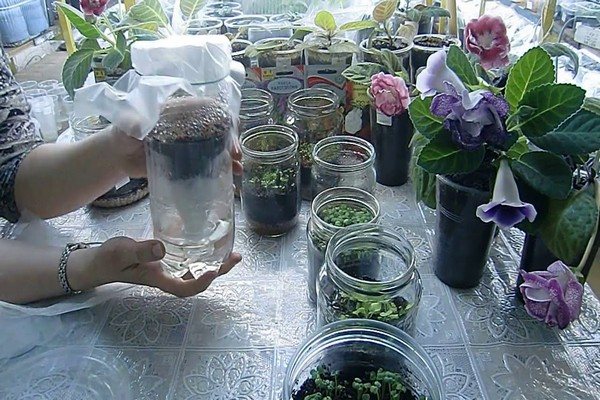

This variety is strong in itself and is able to grow quickly and actively, so the plant must be regularly fed with special preparations and planted in good fertile soil. If the amount of soil in the pot is large, then the roots of the petunia will be strong, thereby the seedling will be large and powerful in size and characteristics.
When planting seeds of petunia Surfinia in a pot or pots, they should contain at least 5 liters of soil. More than 4 seedlings cannot be planted in a thirty liter container.
The land is used loose, light and, most importantly, fertile. As a fertilizer, high-quality fertilizing materials are used that are capable of affecting petunia for a long period of time. Most often, in the store assortment, granules and capsules are presented, which, when combined with a liquid, saturate the soil with useful microelements. But in order for the plant to bloom for a long time and please with its appearance, it is necessary to use not only such fertilizing materials. In the hot summer season, hydrogel balls should be added to the soil, which hold liquid well.
Surfinia pruning
Almost all cultures are formed independently and they do not need human intervention. However, if the grower wants to make the bush more fluffy, he will need to pinch young shoots from time to time.
To preserve the decorative effect of the plant, wilted buds should be removed. Thus, it is possible not only to improve the appearance of the crop, but also to reduce the load on it.
